Australian
and international
exploratory
performance and
media arts
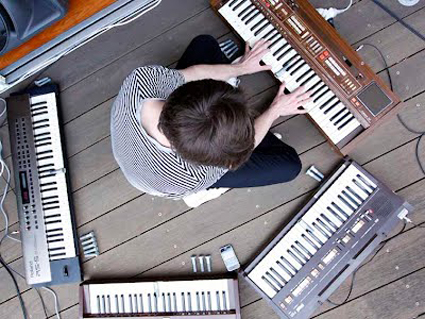
Julian Day, Infinity Room
Since its incarnation in 2009, Vivid festival’s music program has concentrated on the big end of town—major international (and occasionally Australian) artists performing at the iconic pearl of the city (or more an oyster shell), the Sydney Opera House. However this year offers more diversification with activities of all kinds radiating out from the harbour, including the Seymour Centre hosting a series of Vivid events, one of which is the New Wave: Sound program.
Curated by Seymour Centre resident Andrew Batt-Rawden (Chronology Arts), Ndew Wave: Sound is a mini-festival of music that hovers above the genre boundaries of contemporary classical, electroacoustic, jazz, soundscape and even pop. I asked Batt-Rawden about the slipperiness of categorisations.
“It’s very difficult to pin it down to a particular genre because a lot of this music is genre-less, other than calling it art music or contemporary classical. It’s such a broad area that can include a whole plethora of moods, feelings, styles, rhythms, harmonic constructs—it’s really like a new world to explore. That’s why the title New Wave: Sound is relevant. Also it’s playing on the idea of vibrations—sound waves.”
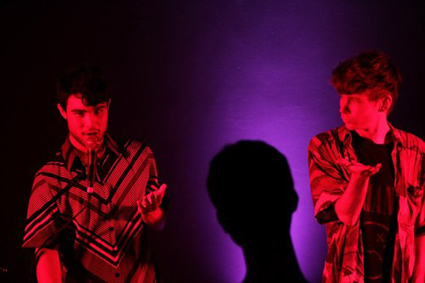
Collarbones
To set the context, the event opens with a forum around “what’s hot” in new music with guest commentators Ignatius Jones (Creative Advisor, Vivid), Marcus Whale (composer, member of Collarbones), Julian Day (composer, presenter on ABC Classic FM), Adam Lewis (host of Radiant on FBi Radio) Lyle Chan (composer, Creative Consultant) and Batt-Rawden. Following this audiences will have to make a difficult choice since the first two concerts are presented simultaneously.
Playing in the Sound Lounge is Italian jazz composer/pianist Kekko Fornarelli (with Giorgio Vendola, double bass and Dario Congedo, drums and percussion) performing laid back jazz meets classical lyricism. Those seeking more angular pleasures should try Abstraction & Pathology, a concert of works by virtuosic electroacoustic composer Anthony Pateras performing with Natasha Anderson (recorder and electronics) and Erkki Veltheim (viola). Pateras, who now lives in Brussels and whose work was recently profiled by Speak Percussion at Maerzmusik in Berlin (see review in RT115), certainly fulfils Batt-Rawden’s desire to program the “epitome of ‘awesomeness’ in electroacoustic music.”
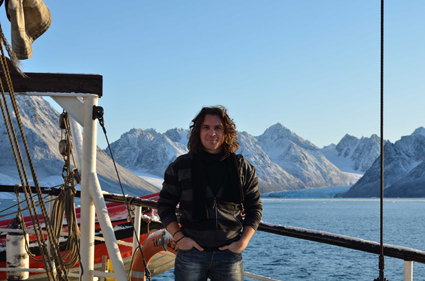
frostbYte
The second day consists of back-to-back performances, starting at midday. They include compositions for bass recorder commissioned and performed by Alicia Crossley; the drone minimalism of Julian Day’s Infinity Room project; a multichannel soundscape with visuals by frostbYte (aka Daniel Blinkhorn); string quartet The NOISE; and various group configurations featuring electric guitarist virtuoso Zane Banks, including Australia’s only guitar quartet, Ampere. The evening finishes up with pop-duo Collarbones (Marcus Whale and Travis Cook).
Batt-Rawden, in his previous role of Artistic Director of the 2012 Aurora Festival, introduced Western Sydney audiences to this eclectic combination of acts so I asked him what it was about these artists that so appealed to him.
“All of the artist who are being presented are people with get-up-and-go, who take the initiative whether that be creative initiative [in their compositions] or in producing fantastic programs…That risk-taking is reflected in the micro-detail of their compositions and performances, as well as the broader programming they have done in other concerts.”
Andrew Batt-Rawden certainly has his share of get-up-and-go and he’s not afraid to think big, asserting, “Although ‘entrepreneur’ can be a dirty word in artistic practice, I don’t think it should be.” While preparation for this year’s program had quite a compressed timeline, he is already planning next year’s event, which will see the relationship with SIMA (Sydney Improvised Music Association which is presenting Kekko Fornarelli this year) developed into a more comprehensive collaboration. Batt Rawden says, “There’s actually an interesting mix of jazz influences with classical training in next year’s program.” But first things first: ride the new wave this year and see where it takes you.
Vivid Sydney @ Seymour: New Wave: Sound, curator Andrew Batt-Rawden, Chronology Arts, Seymour Centre, June 7-8; http://www.seymourcentre.com/new-wave-sound/
You can also check out some video clips of The NOISE , Frostbyte, Julian Day
RealTime issue #114 April-May 2013 pg. web
© RealTime ; for permission to reproduce apply to realtime@realtimearts.net
Frequently messages land in our inboxes that get us calculating our frequent flyer points. This week a cluster of perverse pleasures—Sisyphean tasks, songs of pain and loss, haute cuisine and executions, and the “disintegrating spectacle”—lures us to London.
bill viola, frustrated actions and futile gestures
The eloquent video artist Bill Viola will soon be presenting his latest breathtaking creations in London in a major exhibition, Frustrated Actions and Futile Gestures, at Blain Southern Gallery. The centre piece is the series The Chapel of Frustrated Actions and Futile Gestures (2013) which depicts figures performing repetitive and seemingly futile tasks: digging and re-filling a hole; filling a leaking bowl; dragging a cart up a hill, only to let if roll down again. Complementing these parable-like screen-based works is a diptych—projected onto granite slabs—of an ageing man and woman surveying their naked bodies via torchlight. There will also be works from his Mirage series (2012-13) shot on location in the Mojave Desert and The Dreamers (2013) where Viola returns to the submerged figure, continuing his investigations into the spiritual and the subconscious.
Bill Viola, Frustrated Actions And Futile Gestures, Blain|Southern, London, June 5-27; http://www.blainsouthern.com/gallery-info/london-hanover-square
madam plaza, bouchra ouizguen
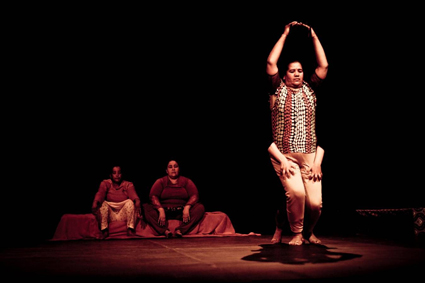
Bouchra Ouizguen’s Madam Plaza
courtesy LIFT
Bouchra Ouizguen’s Madam Plaza
The work of Morrocan-born choreographer Bouchra Ouizguen first came to our attention with her work Ha! presented at Montpellier Danse 2012. Mary Kate Connolly wrote, “What is most delightful about this work is the fact that it surrenders neither to spoof nor to overly earnest posturing. It determines a language of its own, drawn from the body and the characters onstage, which it sticks to without exception.” (RT112) Ouizguen will be premiering another of her works in London (presented by LIFT), as part of Shubbak: A Window on Contemporary Arab Culture. Madam Plaza features the choreographer along with four aïtas—women who sing “songs of pain, loss and impossible love at (communal) celebrations and nightclubs” (website). These women are equally admired and scorned in Morrocan society. You can see a short preview here.
Shubbak: A Window on Contemporary Arab Culture: Madam Plaza, Bouchra Ouizguen’s Company O, presented by LIFT, June 22-July 6; http://shubbak.co.uk/; http://liftfestival.com
trash cuisine, belarus free theatre
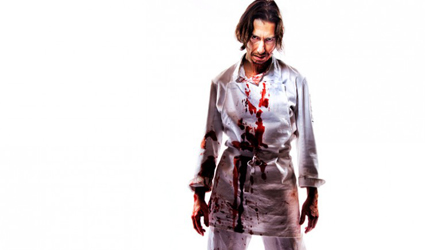
Free Theatre Belarus, Trash Cuisine
courtesy LIFT
Free Theatre Belarus, Trash Cuisine
Also presented by LIFT is the Belarus Free Theatre with their new work Trash Cuisine. The company impressed Sydney audiences back in 2009 with Being Harold Pinter of which David Williams wrote, “an utterly riveting, relentlessly paced and forcefully delivered theatrical presentation. Even simple exchanges bristle with menace and acquire accusatory overtones” (RT89). In Trash Cuisine the company combines the opulence of fine dining with capital punishment. See a chilling segment here.
Trash Cuisine, Belarus Free Theatre, presented by LIFT, May 30-June 15, Young Vic, London; www.liftfestival.com
mackenzie wark, the spectacle of disintegration
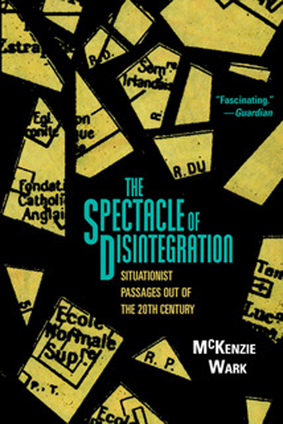 Australian ex-patriot Mackenzie Wark contributed many provocative articles to RealTime in the 1990s on media art and culture (all of which will soon be available as part our Media Art Archive, launching during ISEA). His latest book, The Spectacle of Disintegration is part two of his research into the Situationists. Here he follows the movement after the 1968 riots, including an in depth look at the film work and early game theories of Guy Debord. According to the press release “Wark builds on their work to map the historical stages of the society of the spectacle, from the diffuse to the integrated to what he calls the disintegrating spectacle” (Verso website). Furtherfield Gallery London will be hosting an afternoon discussion with Wark, introduced by writer/academic Dr Richard Barbrook (Imaginary Futures: From Thinking Machines to the Global Village. (Pluto Press, 2007).
Australian ex-patriot Mackenzie Wark contributed many provocative articles to RealTime in the 1990s on media art and culture (all of which will soon be available as part our Media Art Archive, launching during ISEA). His latest book, The Spectacle of Disintegration is part two of his research into the Situationists. Here he follows the movement after the 1968 riots, including an in depth look at the film work and early game theories of Guy Debord. According to the press release “Wark builds on their work to map the historical stages of the society of the spectacle, from the diffuse to the integrated to what he calls the disintegrating spectacle” (Verso website). Furtherfield Gallery London will be hosting an afternoon discussion with Wark, introduced by writer/academic Dr Richard Barbrook (Imaginary Futures: From Thinking Machines to the Global Village. (Pluto Press, 2007).
Mackenzie Wark, The Spectacle of Disintegration, May 25, 4pm, Furtherfield Gallery London, http://www.furtherfield.org; www.versobooks.com
RealTime issue #114 April-May 2013 pg. web
© RealTime ; for permission to reproduce apply to realtime@realtimearts.net
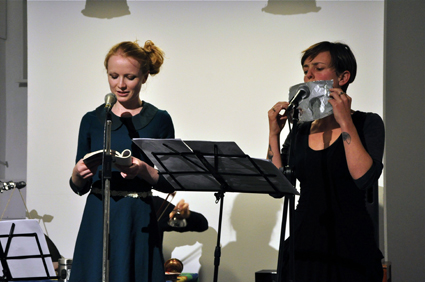
Jessica Wilkinson, Jenny Barnes perform marionette at Conduit Arts, May 9
photo Mandy Kitchener
Jessica Wilkinson, Jenny Barnes perform marionette at Conduit Arts, May 9
conduit arts, melbourne
The Artist Run Initiative Conduit Arts in Fitzroy has a unique operating system: one month it’s home to the visual arts and the alternate month it functions as a music and performance venue. (See Partial Durations blog for Matthew Lorenzons’ review of a recent concert curated by Simon Charles http://partialdurations.wordpress.com/2013/05/13/manteia-marionette/). The directors are now calling for proposals for activities October 2013 to April 2014.
Applications due July 15; http://conduitarts.wix.com/conduitarts#!artproposals/c2zo
templeberg residential writing fellowship
The Templeberg Villa is a Dutch Colonial merchant house in Galle on Sri Lanka’s south coast. In partnership with Writers Victoria, it is offering a one month funded residency to an Australian writer of fiction, non-fiction, performance, poetry or even be a journalist or blogger.
Applications close June 14; http://writersvictoria.org.au/services/fellowships/templeberg-residential-writing-fellowship
still in the loop
librettist workshop, chamber made
Chamber Made Opera, Writers Victoria, The Wheeler Centre, July 29- August 2; http://www.chambermadeopera.com/program/Librettists_Workshop
more…
city of melbourne annual grants
Applications close 17 June 2013.http://www.melbourne.vic.gov.au/aboutcouncil/grantssponsorship/artsgrants/Pages/ArtsFunding.aspx
more…
stephen cummins bequest residencies, performance space
Applications close June 3
http://www.performancespace.com.au/2013/stephen-cummins-2013-callout-queer-artists/
more…
beijing residency, 4a centre for contemporary asian art
Deadline May 31
http://www.4a.com.au/4a-beijing-residency-program/
more…
workshops, networked art forms & tactical magick faerie circuits, cast
With Julian Oliver & Danja Vasiliev (May 31- June 2); Anne Goldeberg & Karine Rathle (June 5-8)
More info http://tacticalmagick.net/workshops
more…
call for percussion scores, campbelltown city council
Deadline for submissions July 1; www.campbelltown.nsw.gov.au/CallforScore
more…
arts house season 1, 2014
Deadline May 31
www.melbourne.vic.gov.au/ArtsHouse/fundinggrants/Pages/Fundingandgrants.aspx
More…
channels video art festival
Deadline June 1
More info www.channelsfestival.net.au/
More…
selected australia council grant deadlines
(for full list see http://www.australiacouncil.gov.au/grants)
Visual Arts: Australia Council Visual Arts Laureate Award and Medal, due May 27, 2013
http://www.australiacouncil.gov.au/grants/2013/visual-arts-laureate
Visual Arts: Creative Australia – New Work, due May 27, 2013
http://www.australiacouncil.gov.au/grants/2013/creative-australia-new-work
Market Development, Visions of Australia and Contemporary Touring Initiative, due May 31, 2013
http://www.australiacouncil.gov.au/grants/2013/visions-of-australia-and-contemporary-touring-initiative
Market Development, Playing Australia, due May 31, 2013
http://www.australiacouncil.gov.au/grants/2013/playing-australia-31-may
Contemporary Music Touring Program, due June 11, 2013
http://www.australiacouncil.gov.au/grants/2013/contemporary-music-touring-program-11-june
International Showcase – Music makers (Previously Live On Stage – International Showcase Program) – due June 19, 2013
http://www.australiacouncil.gov.au/grants/2013/international-showcase-music-makers-19-june-2013
International Markets – Music managers (Previously Live On Stage – Music Managers) – due June, 19 2013 http://www.australiacouncil.gov.au/grants/2013/international-markets-music-managers-19-june-2013
Music: New Work – Writing and Recording, due June 24, 2013
http://www.australiacouncil.gov.au/grants/2013/music-new-work-writing-and-recording-24-june
Music: Presentation and Promotion, due June 24, 2013
http://www.australiacouncil.gov.au/grants/2013/music-presentation-and-promotion-24-june
Theatre: Key Organisations, due June 25, 2013
http://www.australiacouncil.gov.au/grants/2013/key-organisations-theatre
Theatre: Program Presenter, due June 25, 2013
http://www.australiacouncil.gov.au/grants/2013/theatre-program-presenter
RealTime issue #114 April-May 2013 pg. web
© RealTime ; for permission to reproduce apply to realtime@realtimearts.net
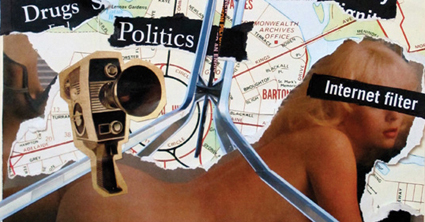
version 1.0, Major Minor Party
major minor party
There are not many subjects theatre company version 1.0 is afraid to tackle. Currently the team is investigating the political intrigues behind the formation of the Australian Sex Party, founded in 2009. We can well imagine that the show will involve some rollicking fun alongside a sensible dose of transcript veracity around the Sex Party’s attempts to expose hypocrisy, fight censorship and generally lobby for a more tolerant nation. Fittingly the show is premiering in Canberra as part of the Centenary celebrations. Let’s hope more delicate Canberrans have recovered from the shock of Patricia Piccinini’s gloriously grotesque Skywhale hot air balloon and are ready for some more cultural provocation.
Version 1.0, Major Minor Party, Canberra Theatre Centre, May 29-June 1; http://www.canberratheatrecentre.com.au/season2013/majorMinor.html
moduluxxx
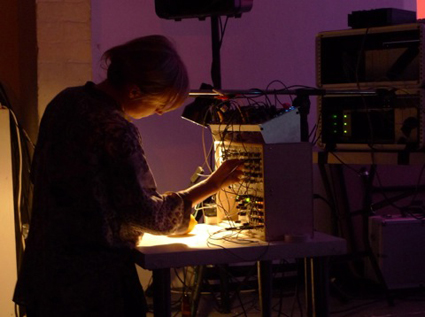
Pia van Gelder performing in Moduluxxx 2012
photo Alex White
Pia van Gelder performing in Moduluxxx 2012
Making music with computers is so old hat. The electronic music-making tools du jour are modular synthesisers. You get a box, fill it with your choice of noise-emitters and effects and patch them together in different combinations to make unpredictable, barely tameable and definitely unrepeatable noise magic. If you want to know more about it you can attend workshops, performances and even a petting zoo—getting your sweaty hands on some knobs and switches—as part of the two-day Moduluxxx festival. Guest artists include festival directors Pia van Gelder and Alex White, along with Russell Haswell (UK), Wired Lab’s David Burrastan and Nokes & Cook.
Moduluxxx, Sydney various venues, May 24-25; http://moduluxxx.com
laura altman & monica brooks duo
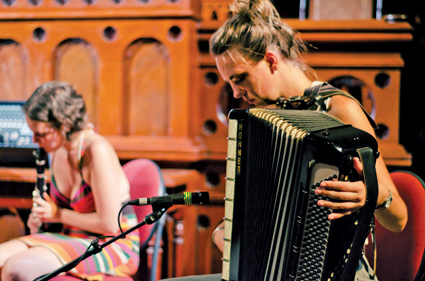
Laura Altman, Monica Brooks
On the other end of the noisemaking spectrum are the super-quiet experiments of Laura Altman on clarinet and Monica Brooks on accordion. Describing a live performance by the duo as part of the exhibition In a Silent Way at Hobart’s CAST gallery, Andrew Harper wrote “the time the two players described with sound hung together with a brittle elegance. People who seem to know their instruments well enough not to demonstrate their skill make fascinating players” (RT112). Their concert is the first in the New Music Networks’ annual Mini Series profiling emerging and independent artists.
New Music Network Mini Series: Laura Altman & Monica Brooks; Old Darlington School, Sydney University, May 25; http://www.newmusicnetwork.com.au/series.html
spanish film festival
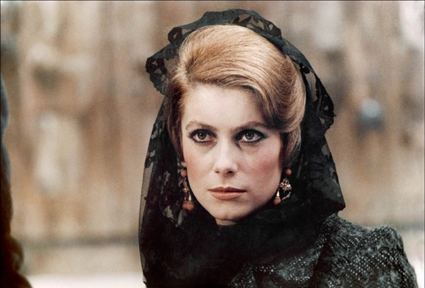
Catherine Deneuve in Luis Bunuel’s Tristana (1970)
The 16th Spanish Film festival will be spreading some Latin-loving, warmth and charm across Australia in June. It opens with A Gun in Each Hand (Una pistola en cada mano, 2012) by Cesc Gay, a comedy about the changing role of men and masculinity and concludes with a rare big screen showing of Luis Buñuel’s Tristana (1970), starring Catherine Deneuve in a dark tale of patriarchal passion and possession. In between will be 20 Spanish and Spanish-speaking Latin American films, many Australian premieres. Natalia Beristáin (Mexico), director of She Doesn’t Want to Sleep Alone (No quiero dormir sola), which premiered at the 2012 Venice Film Festival, will be touring the country as a special guest.
16th Spanish Film Festival, presented by Estrella Damm, Melbourne, Perth, Brisbane, Adelaide, Canberra, Sydney, Byron Bay, June 12-26 http://www.spanishfilmfestival.com/
melbourne international animation festival
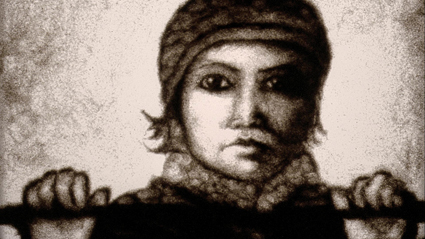
Marieka Walsh (AUS), The Hunter, Melbourne Animation Festival
This year’s MIAF runs for 11 days offering a huge amount of animated action. There are eight screening programs of international competition entries alone. Then there are showcases from Canada, Lithuania, Portland (home of edgy and indie—Bill Plympton, Matt Groening, Gus Van Sant etc) and of course Australian showcases as well. There’ll also be the first ever MIAF conference, Render (June 21-22), with keynote speaker Koji Yamamura who will be presenting retrospectives of his animations for adults and children. To help you make your program choices see the preview in RealTime 115.
Melbourne International Animation Festival, ACMI Cinemas, June 20-30; http://www.miaf.net/2013/home.html
elvis richardson, slide show land
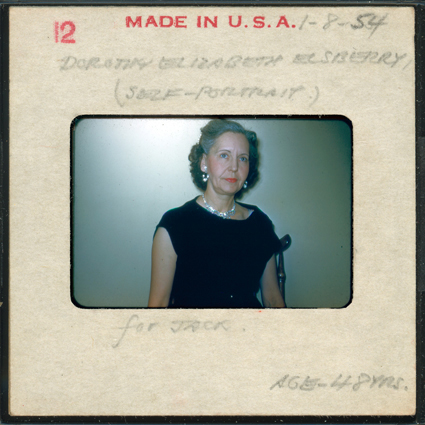
Dorothy (Self Portrait), 1964-2013, 35mm slide, Slide Show Land series, Elvis Richardson
Elvis Richardson has been buying up big on e-Bay—she has over 10,000 35mm slides dating from 1940-1980. In her exhibition, Slide Show Land at Nellie Castan Gallery, she reconfigures these memory fragments as projections and photographic prints, set in an environment of sculptural objects constructed from domestic furniture. Richardson is investigating “sentimental feelings of reminiscence, as well as the pervasive familiarity of the image economy found today on facebook and flickr” (press release).
Elvis Richardson, Slide Show Land, Nellie Castan Gallery, Melbourne, June 6-29; http://www.nelliecastangallery.com/artist/10.127.281/elvis-richardson-slide-show-land.html
tony albert, projecting our future, agnsw
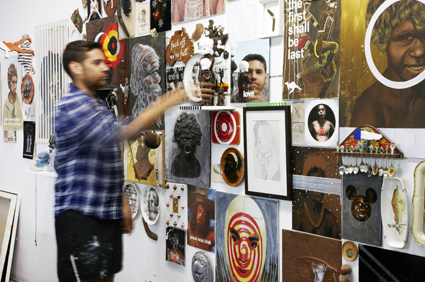
Tony Albert, Projecting our future 2002-13 (detail in progress), installation made of reworked objects, sculptures and paintings; original photographs, paintings and drawings and three unique artworks by Daniel Boyd, Dale Harding and TextaQueen
private collection, New Zealand © the artist
Tony Albert, Projecting our future 2002-13 (detail in progress), installation made of reworked objects, sculptures and paintings; original photographs, paintings and drawings and three unique artworks by Daniel Boyd, Dale Harding and TextaQueen
Tony Albert also reconfigures images from the past. The final part of a trilogy, Projecting our Future at the AGNSW Project Space, combines kitsch, souvenir-type representations of Aboriginality with contemporary illustrations and paintings. The complex multilayered assemblage interrogates “cultural difference in relation to pride, optimism and solidarity” (website). And while at AGNSW you can check out Brenda L Croft’s striking portrait series in the Yirbana Gallery (until Sept 8).
Tony Albert, Projecting our future, AGNSW Contemporary Project; until June 7; http://www.artgallery.nsw.gov.au/exhibitions/tony-albert/
loading the silence: australian sound art in the post-digital age, linda kouvaras
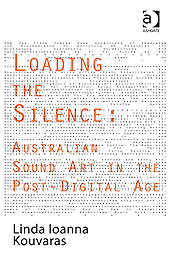 While still small in number, the books about Australian experimental music and sound are beginning to claim some space on library shelves. The latest addition is by academic Linda Kouvaras, the result of an ARC Research grant. It investigates “experimentalism from its inception in the early twentieth century…[and] how sound is embedded within local, national, gendered and historical environments” with a particular focus on Australian practice (press release). The book will be launched by Warren Burt, June 5, at the Grainger Museum, The University of Melbourne.
While still small in number, the books about Australian experimental music and sound are beginning to claim some space on library shelves. The latest addition is by academic Linda Kouvaras, the result of an ARC Research grant. It investigates “experimentalism from its inception in the early twentieth century…[and] how sound is embedded within local, national, gendered and historical environments” with a particular focus on Australian practice (press release). The book will be launched by Warren Burt, June 5, at the Grainger Museum, The University of Melbourne.
Published Ashgate by http://www.ashgate.com/isbn/9781409441564
still in the loop
anne landa award for video and new media arts 2013, agnsw
Anne Landa Award for Video and New Media Arts 2013, May 16-Jul 28, Art Gallery of New South Wales
http://www.artgallery.nsw.gov.au/exhibitions/space-between-us/
more…
everyday rebellions, gertrude contemporary
Gertrude Contemporary, Melbourne, May 11- June 8
http://www.gertrude.org.au/exhibitions/gallery-11/current-13/
more…
joachim koester, frances stark, ian potter museum of art
Ian Potter Museum of Art, until June 2; http://www.art-museum.unimelb.edu.au/exhibitions/exhib-date/2013-03-20/exhib/joachim-koester-tarantism
more…
direct democracy, muma
Monash University Museum of Art, until July 6
http://www.monash.edu.au/muma/exhibitions/upcoming/direct-democracy.html
more…
bloom—space, aeaf
Australian Experimental Art Foundation, Adelaide, until June 1
http://aeaf.org.au/exhibitions/21_bloomspace.html
more…
peter dailey, apparition: the syndicate ii
Fremantle Arts Centre until June 2; http://fac.org.au/events/288/peter-dailey-apparition-the-syndicate-ii?mid=12
more…
networked art forms & tactical magick faerie circuits, cast
Hobart, May 31-June 30;” http://tacticalmagick.net/
more…
conduit arts space initiative
May Music & Performance Program, Conduit Arts Initiative, Fitzroy
Full program http://conduitarts.wix.com/conduitarts#!program-music/ch3c
more…
diffuse, uts
May 23 & June 6, Bon Marche Studio, UTS
http://diffuse2013.wordpress.com/
more…
opal vapour, jade dewi tyas tunggal, mobile states
Adelaide, Perth, Hobart, Cairns, McKay, Brisbane, Canberra, Blacktown
May-June, see website for details http://performinglines.org.au/productions/opal-vapour/; http://opalvapour.com.au/
more…
gemeinboeck & saunders, velonaki, ingram, artspace
ISEA satellite exhibition, May 2-June 16 http://www.artspace.org.au/gallery_upcoming.php
more…
composition to movement festival, creative practice lab, unsw
May 24-26, part of Vivid Sydney
http://sam.arts.unsw.edu.au/c2m
more…
eve and eve, rebecca agnew, 24hr art
until June1
http://www.24hrart.org.au/
more…
hatched: national graduate show 2013, pica
until June 9
http://www.pica.org.au/
more…
shadowlife, bendigo art gallery
until July 28 http://www.bendigoartgallery.com.au/Exhibitions/Current_Exhibitions/Shadowlife
more…
RealTime issue #114 April-May 2013 pg. web
© RealTime ; for permission to reproduce apply to realtime@realtimearts.net
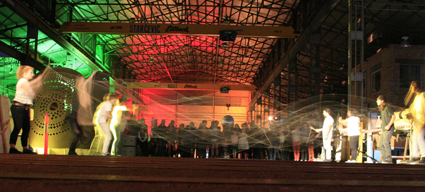
Lavender, Mist
photo Eric Griswold
Lavender, Mist
URBAN ART PROJECTS IS OUT PAST THE AIRPORT IN THE LIGHT INDUSTRIAL ZONE. IT’S A VAST LET’S-BUILD-A-SHIP SIZED INDUSTRIAL SHED, AND TONIGHT IT IS FILLED WITH THE DEEP ROARING NOISE OF A FURNACE SMELTING BRONZE.
Two men go through a slow and very careful ritual to make the pour. Sparks of boiling metal spit into the air. Then claps all round for the first piece of the Listening Museum, Clocked Out and Ensemble Offspring’s latest collaborative foray into concerts in other places.
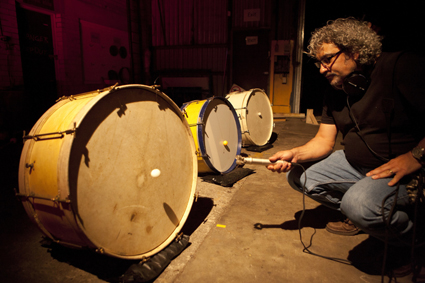
Alvin Lucier’s Music for Pure Waves, Bass Drums and Acoustic Pendulums
photo Sean Young
Alvin Lucier’s Music for Pure Waves, Bass Drums and Acoustic Pendulums
The space is set up as a series of stations, some things are on all the time, some are in specific time-slots. People move about, grab drinks, move about some more. Alvin Lucier’s wonderfully clever Music for Pure Waves, Bass Drums and Acoustic Pendulums is set up at the entrance—inaudible low frequency sine waves bouncing ping pong balls off the resonating skins of bass drums. Another Lucier piece, In Memorium John Higgins, sets a slowly rising sine wave against held notes on clarinet. A truly beautiful work that revealed one of the classic problems of sound in a shared space—bleed from one work to another. Difficult if not impossible to overcome, the interjecting blab of sound from other works interfered annoyingly with Rosemary Joy’s Beauty Boxes, a soft and delicate piece for two performers playing tiny chests of drawers and the sounding objects within.
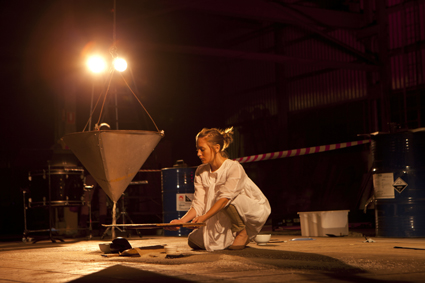
Rebecca Lloyd-Jones performing Erik Griswold’s Spill
photo Sean Young
Rebecca Lloyd-Jones performing Erik Griswold’s Spill
Strangely though, the bleed worked for Erik Griswold’s Spill, where rice leaks out of a swinging pendulum to sound onto surfaces that are moved and changed by the performer. The initial subtlety of surface variation was lost in the general hubub, but eventually the surfaces were set to hard tiles and rice became a drum machine against which other pieces worked their rhythms.
Griswold also composed and played in my two favourites for the night. Early in the program was the premiere of Action Music for piano, percussion, bass clarinet and violin. The piece is a single quirky line—cartoon music for tomorrow, snappy fragments and synced up time slices of humour held together by a score that specifies rhythm, mood and attitude rather than pitch. The ensemble playing is superb—instruments mesh perfectly, the virtue of having the musicians play as an acoustic ensemble rather than with sound reinforcement trying to fake a balance for them.
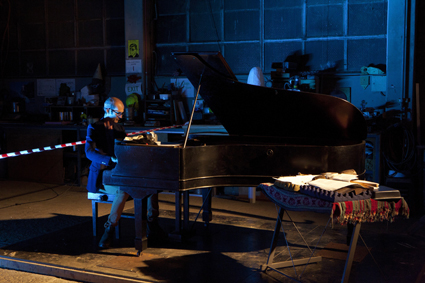
Erik Griswold, Ecstatic Music
photo Sean Young
Erik Griswold, Ecstatic Music
And then toward the end, Griswold performs the stunning Ecstatic Music. Each key is prepared to hover somewhere in the E major world and then on this reduced piano Griswold plays rapid arpeggios, sprints and flourishes, hunched over the keyboard and rocking on the stool like a Hollywood maestro. The composer-pianist emotes for us all through his hyper-acute feelings and hyper-fluid fingers. Except that it is a reduced piano so nothing like Sturm und Drang falls out. Instead we get tinkles, with occasional variation. Despite the effort, despite the visibly heroic struggles of the performer, the deepest feelings remain trapped by the inadequate means at hand. We bear witness to the gulf between ambition and achievement, between ourselves-in-ourselves and ourselves in others. Normal life. Australia’s Got Talent.
The Listening Museum, Clocked Out and Ensemble Offspring, Urban Art Projects, Brisbane, April 20, 2013; http://www.uap.com.au/; http://www.clockedout.org/; http://ensembleoffspring.com/
RealTime issue #114 April-May 2013 pg. web
© Greg Hooper; for permission to reproduce apply to realtime@realtimearts.net
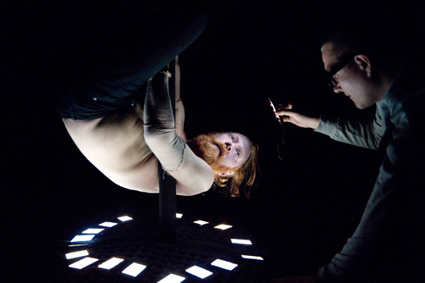
Skye Gellmann, Blindscape, Next Wave Festival 2012
photo Sarah Walker
Skye Gellmann, Blindscape, Next Wave Festival 2012
When performance art works from the past are re-enacted by others, what can that mean? When live art creates intimate and visceral encounters, what precisely is the art involved? And when the audience becomes the subject of the work, where exactly is the artist in the equation? The nature of performance is changing and its parameters expanding.
RealTime 115 will focus on the body in contemporary performance, whether in the Kaldor Public Art Projects’ 13 Rooms, in circus, live art dance or burgeoning game playing theatre. Our subject can be the body of an artist, a performer or an audience member at a time when the lines between these roles are as permeable as those between artforms.
in the body in question:
two views of 13 rooms
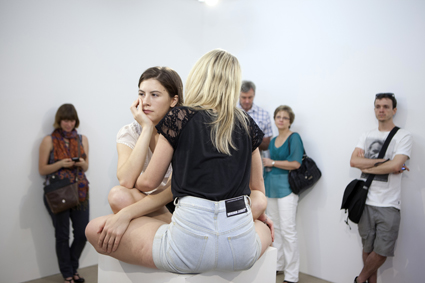
Clark Beaumont, Coexisting, 2013, ommissioned and performed by the artists for Kaldor Public Art Project 27: ‘13 Rooms’
photo Jamie North/Kaldor Public Art Projects
Clark Beaumont, Coexisting, 2013, ommissioned and performed by the artists for Kaldor Public Art Project 27: ‘13 Rooms’
Ilana Cohn approvingly reviews the hugely popular 13 Rooms’ “living sculpture” performances some of which are re-enactments of works created by artists to be performed by themselves under the banner of performance art. In Sydney’s performance scene responses ranged from enthusiastic to hostile, so we asked prominent Australian performance artist Barbara Campbell for her take on 13 Rooms.
yvonne rainer: re-enacted or transmitted?
Nicely timed, American dance artist Sarah Wookey appeared in Sydney around the time of 13 Rooms, recreating a seminal work by Yvonne Rainer. Meredith Morse writes, “Wookey is one of five people vested by Yvonne Rainer—certified, Wookey says—to perform and teach the four-and-a-half-minute Trio A. Re-engaging with Trio A is timely: the Judson Dance Theater’s 50th anniversary was celebrated this past year, and the question of re-performances of 1960s-70s works remains topical.”
put the body back into circus
Asking what is the standing of circus as art, Antonella Casella argues against “a prevailing opinion that circus skills should only be harnessed for performance when they reflect a narrative/contextual intent—implying that the display of circus skills, in and of themselves, is somehow gratuitous.”
close body encounters at spill
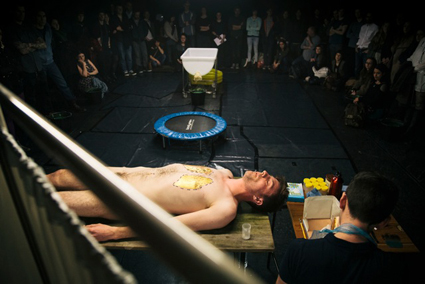
Martin O’Brien, Last(ing), Spill Festival London
photo Guido Mencari
Martin O’Brien, Last(ing), Spill Festival London
Cat Jones, Madelaine Hodge and Julie Vulcan report from London on strange encounters with bodies in the SPILL Festival of Live Art. Not for the nervous, Spill included blood spilling, mucous expectoration, a visit to the apparently dead and witnessing “glorious genitalia” experiments. But SPILL also offered hand-holding walks with strangers and watching a dress being made out of cake. There’s serious intent in these live art foregroundings of the body, that also challenge the very notion of art.
the audience as the body in the work
Playwright Robert Reid reports from his UK encounters with game playing theatre. He writes that works by the likes of Coney “allow for and respond to player agency within constructed narrative environments. They give participants the chance to practice ‘ways of being’ in ‘not for real’ spaces.”
Also in RealTime 115:
Robyn Archer invites us to the next stage of the Canberra 100 celebrations.
Benedict Andrews on thinking through Genet’s The Maids for his STC production featuring Isabelle Huppert and Cate Blanchett as the murderous sisters.
Festival reports: Castlemaine Festival, Vancouver’s PuSh, Tokyo’s Azumabashi Dance Crossing, Melbourne’s Light in Winter and Brisbane’s Exist-ence.
Regional arts: an interview with Vic McEwen of CAD Factory which presents innovative performance and installation work across the Riverina region. Kathryn Kelly reports on developments on the Gold Coast to nurture a challenged cultural scene.
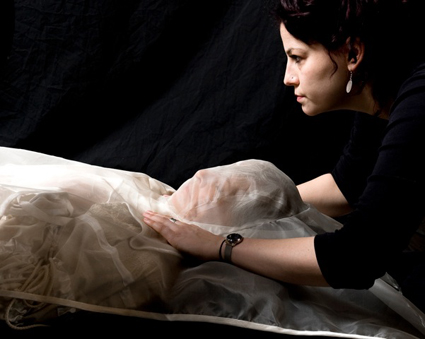
Anatomy – Soul
photo Devika Bilimoria
Anatomy – Soul
In film, Dan Edwards looks at Australian arts documentaries and Kirsten Krauth reviews Jane Campion’s much-debated Top of the Lake TV mini-series.
Dancer Rennie McDougall interviews dancer and choreographer Luke George; Jana Perkovic reviews Menagerie, the first production in the MTC’s NEON season; Matthew Lorenzon previews the 2013 Totally Huge Festival of New Music; and Polly Dance reviews Julie Gough’s Lost World [1] video installation in Hobart.
RealTime issue #114 April-May 2013 pg. web
© RealTime ; for permission to reproduce apply to realtime@realtimearts.net
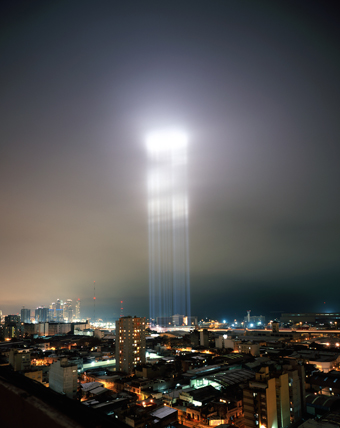
Ryoji Ikeda, Spectra (Buenos Aires), site-specific installation, 2012
© Ryoji Ikeda / Dark Mofo 2013 – Museum of Old and New Art (MONA), Hobart Tasmania
Ryoji Ikeda, Spectra (Buenos Aires), site-specific installation, 2012
MUSHROOMING IN HOBART TASMANIA THIS WINTER IS DARK MOFO A NEW FESTIVAL AND TWIN TO HOBART’S SUMMERTIME MONA FOMA.
Among the visual art highlights of DARK MOFO are the opening of MONA’s latest exhibition Red Queen; Sound to Light, a live collaboration between artists in Hobart and Melbourne; the aesthetico-engineering marvels of Ian Burns at the Tasmanian Museum and Art Gallery; and, destined to reset your sense of selfhood, at Hobart’s Mac1 wharf is the exhibition Beam in Thine Own Eye.
Beam in Thine Own Eye features 14 artists, including Kurt Hentschlager, Ryoji Ikeda, Matthieu Briand, Gregorio Zanon, Tim Bruniges and the legendary Michelangelo Pistoletto, a leader of the Italian Arte Povera movement. The title is borrowed from Matthew 7:3, purposefully tethering the recent with the ancient. David Walsh states in a program note that beyond its moral lesson “it beautifully conjures the notion of our reality shining from within.” The question remains, will Beam in Thine Own Eye convert the uninitiated?
Since ancient times the limits of knowledge have been contemplated with metaphors of light, darkness, sound and silence; likewise, by employing cutting-edge art, Beam in Thine Own Eye’s curators hope to enable an encounter with the unknowns of nature by testing the limits of cognition, feeling, normative reality and selfhood in its audience. Unlike the cosmologies of many ancient thinkers, Beam in Thine Own Eye will doubtless leave the visitor to figure out any grand conclusions on their own. Yet by letting the visitor’s “mind’s eye shine” it can be said Walsh perhaps intends to relate the experience of art to that of mystical ecstatics.
A likely DARK MOFO highlight will be Ryoji Ikeda’s spectra [tasmania] (2013), a grid of 49 xenon lights above the Queens Domain bordering Hobart CBD. Clearly aimed to be the ultimate tribute to numinosity within the festival, spectra will surely need the right kind of night-sky to strike awe.
Light is further revealed as the strange stuff of intelligence when transmuted through Ikeda’s audio-visual installation data.tron [3 SXGA+ version]. The Greeks coined ‘dianoetic’ to conceptualise a certain cosmic intelligence and perhaps here Ikeda is expressing pixellated mathematical data as intelligence; a vast immersive field of ‘data- noetics.’
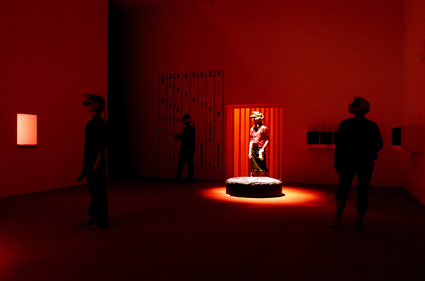
Mathieu Briand, Derriere le monde flottant, Musee d’Art Contemporain de Lyon; Beam In Thine Own Eye – Dark Mofo 2013 – Museum of Old and New Art
photo Bruno Amsellem, image courtesy the artist
Mathieu Briand, Derriere le monde flottant, Musee d’Art Contemporain de Lyon; Beam In Thine Own Eye – Dark Mofo 2013 – Museum of Old and New Art
Sydney based Tim Bruniges’ Continuum (2012) employs a vacillating blue orb of light and quadraphonic sound perpetually emitting a “sonic barber’s pole.” The artist hopes to hypnotically envelop the visitor in its orbit. In another immersive interactive titled SYS*05.REE*03/ SE*1 MOE*2-7 (2000–13), Matthieu Briand will have you and six others wearing backpacks rigged up to video camera helmets in an experiment testing the conventions of personal cognition within an ethos of nomadism. Participants will experience how the real, the virtual, the mental and the physical coalesce. Like a passive form of Trātaka meditation. Anish Kapoor’s Imagined Monochrome (2009) will have you lie on a massage table, your eyelids used as a screen for optical effects.
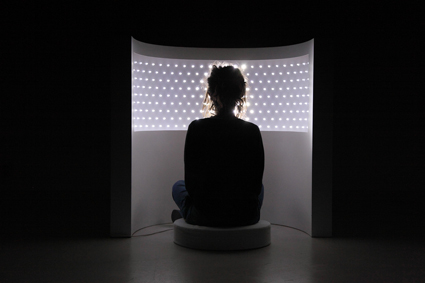
Ivana Franke, Seeing with Eyes Closed, (2013); Beam In Thine Own Eye – Dark Mofo 2013 – Museum of Old and New Art
courtesy the artist
Ivana Franke, Seeing with Eyes Closed, (2013); Beam In Thine Own Eye – Dark Mofo 2013 – Museum of Old and New Art
Beam in Thine Own Eye raises questions about perceptual reality; just what is the mind’s eye? Where do images exist, if anywhere? What can we learn by assaulting the retino-neural reception of light? Ivana Franke invokes these questions by sculpting experience with light, space and darkness. In Seeing with Eyes Closed [SWEC2] (2013) the visitor is subjected to repeated pulses of light forming spectral imprints on the ‘mind’s eye.’
In Giuseppe Penone’s Rovesciare i propri occhi (To Reverse One’s Eyes, 1970), the artist took photos of himself wearing mirrored contact lenses, subverting what is taken for granted as the real. Is the outward appearance of the iris and cornea more real than the eye’s function: to make contact with the radiance of external appearance?
Michelangelo Pistoletto’s sculpture Cubic Metre of Infinity (1966) works with similar logic. Sold for one million US dollars at Christies last year Cubic Metre of Infinity is arguably an icon of icons in art theory, hence well placed to be Beam’s altar. Cubic Metre of Infinity is best interpreted through Pistoletto’s wonderfully elaborate texts: “Soul” (1983), “Art takes on Religion” (1978) and “Division and Multiplication of the Mirror” (1978). One of Pistoletto’s preoccupations is with the production of sacredness; he wants to “reconstruct objectively the centre of spirituality of art,” to evoke an infinite consummating of the sacred spaces of all doctrinal belief systems. Its as if the artist were trading in every debate about which way is the only way by mirroring all artistic and religious representations into a cubic metre of infinity.
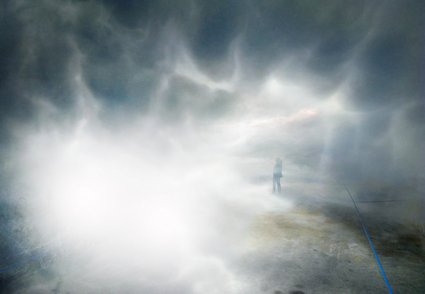
Kurt Hentschlager, Zee, Beam In Thine Own Eye – Dark Mofo 2013 – Museum of Old and New Art
courtesy the artist
Kurt Hentschlager, Zee, Beam In Thine Own Eye – Dark Mofo 2013 – Museum of Old and New Art
If you need one last real reason to visit Hobart this winter it is the promise of Kurt Hentschlager’s ZEE (2008), a work that redefines substance abuse where the substance to be abused is your cognitive processing capacity. At its maximal encounter Hentschlager promises wondrous fractal imagery that will form your mind’s eye.
Museum of Old and New Art: Beam In Thine Own Eye, curated By Olivier Varenne, Nicole Durling; artists Mathieu Briand Tim Bruniges, Lara Favaretto, Ivana Franke Fabien Giraud + Raphaël Siboni, Kurt Hentschläger, Ryoji Ikeda, Alfredo Jaar, Anish Kapoor, Giuseppe Penone, Michelangelo Pistoletto, Lawrence Weiner, Gregorio Zanon; MAC 1, Hobart, June 14-July 28; DARK MOFO, Museum of Old and New Art, June 13-23; www.darkmofo.net.au
RealTime issue #114 April-May 2013 pg. web
© Shane Eastwood; for permission to reproduce apply to realtime@realtimearts.net
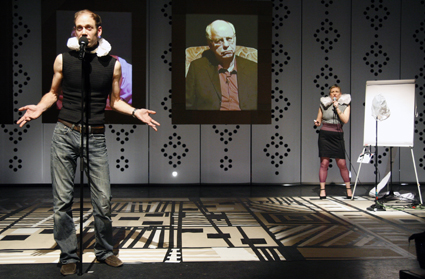
Testament, She She Pop
photo Doro Tuch
Testament, She She Pop
Listen to my story, it might be true. Some version of biographical performance was at the core of many shows at Vancouver’s PuSh 2013. ‘This is my life, your life, our lives’—the strength (or weakness) of such truth-claims was only as good as the artist’s aesthetic muscle. Some had trained harder than others.
Testament
Testament by She She Pop (Germany) mines Shakespeare’s King Lear for insights on contemporary intergenerational issues such as inheritance and elder care. Three Lears, untrained performers in their 70s, and their four real-life progeny (permanent members of the company) confront, empathise with and sometimes court one another’s favour.
As in King Lear, there is humour: one of the fathers, Manfred Matzke, a physicist, keeps it logical by calculating the exchange of love, which he calls “impulse,” and property—“emissions,” between parent and child, using algebraic equations drawn on a flip chart. Lear’s mistake was to release his “emissions” too soon; once his children had received all of his property they had no incentive to return “impulse.”
There is also brutal truth: Joachim Bark speaks of the shame he felt when, in an earlier work by She She Pop, he was forced to look up his daughter’s shirt as she wrestled with another woman while suspended above the audience. Bark has no objection to nudity as long as it’s justified. When witnessing an older actor of the German stage tossed naked during the storm scene from King Lear, Bark had felt the gesture was symbolically appropriate. His analysis justifies what happens next in Testament: the fathers are stripped down to their underwear while the daughters dance a storm around them.
The presentational and task-oriented performance style of Testament keeps the investigation open to the audience. The tasks are straightforward: sing a song to your daughter, read some relevant text from Lear, describe the algebraic formula while you are drawing it, et cetera. It’s the rhythm with which the tasks are arranged that gives the sum of the parts emotional momentum and devastating clarity.
Cédric Andrieux
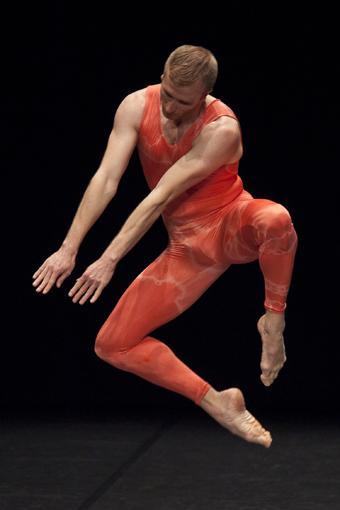
Cédric Andrieux
photo Marco Caselli Nirmal
Cédric Andrieux
As in previous shows I’ve seen by choreographer Jérôme Bel, the rules of the game are strict. On a bare stage, he tightly controls the gestural and vocal performance of Cédric Andrieux, a statuesque dancer in his mid-30s. Andrieux performs excerpts from his life as a dancer, demonstrating training sequences and recreating past shows. Occasional comments about a past love relationship are kept to a minimum. Andrieux almost always speaks to us directly. We return the gaze. It’s implicit in this controlled situation that, while engaging in direct visual ‘conversation’ with Andrieux, we must never approach the stage. Nor should we vocally interrupt the chronicle. And yet for all these constraints, the rhythm of the piece is so expertly constructed I have no desire to disrupt it. Andrieux’s inadvertent twitches reveal a lot. The constraints amplify his inherent charm. By the end I feel I know nothing about Andrieux as a person, but everything about him as a dancer. As in Testament, aesthetic rigour in the form of simplicity of address creates a deeply engaging encounter between spectator and performer.
Photog
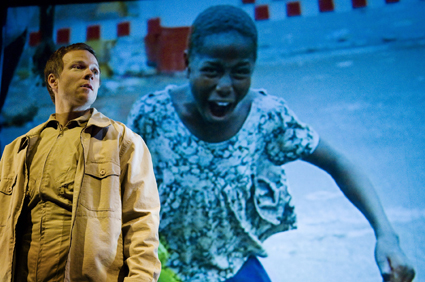
Boca del Lupo, Photog
photo Karri North
Boca del Lupo, Photog
Photog by Boca del Lupo (Vancouver) consists of verbatim extracts from the testimony of several conflict photographers. Boca has chosen to collapse these into one psychologically consistent character named Thomas Smith, played by producer-actor Jay Dodge. A large screen framing the back of the stage features stunning photographs from conflict zones—human beings shot up, crying, dying. It would take a world-class performer to match the drama of those super-charged images. Dodge’s performance, as well as live-feed projections of him onto the photographs, obscures the source material… and the issue. By fusing the various testimonies into one fictional character, who does Photog ultimately serve, the work of the photographers or the artistry of Boca del Lupo? And if it’s the latter, how well does Boca’s work stand up to the artistry of the photographers? To me it seems a mismatch.
Winners and Losers
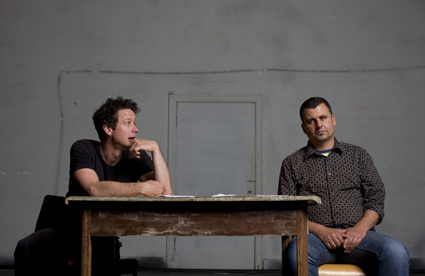
James Long, Marcus Youssef, Winners and Losers
photo Simon Hayter
James Long, Marcus Youssef, Winners and Losers
Like Boca del Lupo, James Long (Theatre Replacement) and Marcus Youssef (Neworld Theatre) default to psychological realism as they offer a confessional of privilege in our society of haves and have-nots. Flanked on either side of a rough wooden table, the two play a question-and-answer game: one of them names a topic (“being an only child”) or celebrity figure (Tom Cruise) and they debate its status as a “winner” or “loser.” The topics get personal. Sort of. Long and Youssef perform stage versions of themselves each can live with, but these fictionalised portraits don’t match the implied intent of the piece, which seems to be to create a public forum in which the two artists offer up their authentic selves as examples of self-serving combatants in a dog-eat-dog capitalist system. Instead they fall back on performing carefully rehearsed routines as if occurring for the first time. This includes an obviously choreographed and not very dangerous-looking wrestling match (why not a real wrestling match with an unplanned outcome?). Similarly, at the closing of the show they pretend their partnership has been irreparably damaged: “It’s over!” they say in unison. Of course we know full well the two are about to embark on a national tour. The show’s pretence of self-revelation looks like a con, but not the kind of rigorous aesthetic con that asserts its own truth.
The biggest problem with Winners and Losers is its politics. If this is a show about the cost of privilege in our society, it offers only the upside. The two performers serve up a bit of liberal guilt mixed with a lot of self-justification, and ‘confess’ to having family incomes of $100,000 or more. They lack a foil in the form of, say, an undocumented immigrant labourer or a single working parent who can’t afford daycare. The truly disenfranchised have no voice in a work that professes to embrace “the ruthless logic of capitalism.” In this show, everyone’s a winner, baby.
I, Malvolio
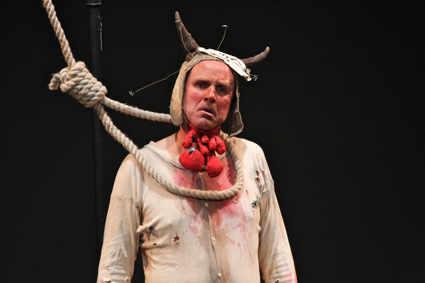
Tim Crouch, I Malvolio
photo Bruce Dalzell Atherton
Tim Crouch, I Malvolio
Moving away from the ‘genuine’ biography, Tim Crouch (UK) gives us a villainous first-person fiction of a fictional villain. Malvolio, the ludicrous, shamed and much-loved fool of Shakespeare’s Twelfth Night, returns from the dungeons of Illyria to turn the tables on those who have most revelled in his downfall—the audience. In the delicious sado-masochistic exercise to come Crouch invites us to mock him, then punishes us for it. Back and forth he expertly works us while demanding retribution for wrongs we have inflicted on Malvolio over the past 500 years.
I felt some relief in this production, lacking as it was in any claims to documentary truth (and perhaps implicitly critiquing such performances through its playful appropriation of autobiographical performance). That it felt as true as anything else I’d seen is due to Crouch’s virtuosity. His work is immaculately structured, while remaining open to spontaneous impulses. In other words, he sure knows how to work a crowd. His work with the text is also masterful—he has enviable range, colour and specificity. And perhaps it is in I, Malvolio that we really get to see the “ruthless logic of capitalism.” Malvolio, believing he is uniquely necessary to those he serves, and tricked into thinking his master is in love with him, discovers he is nothing more than a lackey, as replaceable as any small cog in a system where romantic love is the preserve of those who can afford such indulgences.
Still Standing You
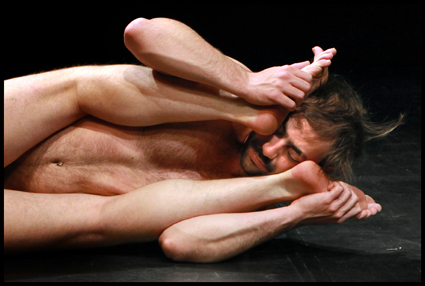
Pieter Ampe, Guilherme Garrido, Still Standing You
photo Phile Deprez
Pieter Ampe, Guilherme Garrido, Still Standing You
Contemporary dance is often about the dancer as both subject and object of performance. The personal story is already ‘written’ on the body. Jérôme Bel achieves this with his stripped down presentations of unadorned performers. Pieter Ampe (Belgium) and Guilherme Garrido (Portugal) go for even fuller exposure in Still Standing You. Drawing on the playful and masochistic games of their boyhoods, the two men put on cartoonish alter egos (dinosaurs, exotic birds), ride each other, hit each other, and get naked. The serious/comic manner in which they up the ante of consenting physical abuse makes you wonder how far they will go. Pretty far. It doesn’t take long before each has a grip on the other’s foreskin and is testing its elasticity with corkscrew twists and painful elongations. Now that’s an exposé. If Winners and Losers is about the socio-economic factors that fracture the relationship of two theatre buddies, this show is about the socio-physical extremes to which two dance buddies will go in search of a deeper bond. (See also Tim Atack’s review of the duo’s 2010 performance of Still Standing You at In Between Time in Bristol)
Lear
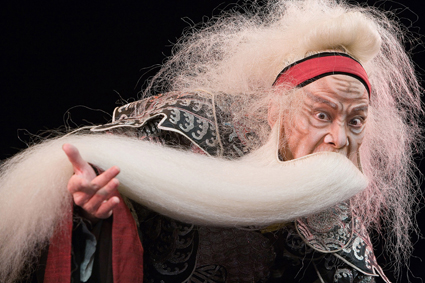
Wu Hsing-Kuo, King Lear
photo Dirk Bleicker
Wu Hsing-Kuo, King Lear
Wu Hsing-Kuo of Contemporary Legend Theatre (Taiwan) uses King Lear as an analogue of his troubled relationship with his former opera master. Wu had been severely criticised for trying to update the conventions of Peking Opera. To Wu’s regret, he and his master never reconciled. In this solo show he purges his demons, focusing on the father-son relationships in Lear, and minimising the role of the daughters. In Act III Cordelia becomes a stand-in for Wu’s master, and it is through her that he makes his apologies and purges his guilt. Unfortunately, minimising the role of the daughters in Lear leaves us with the familiar father-son tropes Hollywood relentlessly subjects us to, from Star Wars to The Lion King. I prefer the complex considerations of Lear’s daughters who are forced to deal with their father’s juvenile sense of entitlement, both in the original play, and in She She Pop’s feminist reworking of it.
PuSh international Performing Arts Festival 2013, artistic director Norman Armour, Jan 15-Feb 3, Vancouver, http://pushfestival.ca
This article originally appeared as part of RT’s Online e-dition May 15, 2013
RealTime issue #115 June-July 2013 pg. 16-17
© Alex Lazaridis Ferguson; for permission to reproduce apply to realtime@realtimearts.net
While the Head On Photo Festival in Sydney is the new kid on the block, starting up in 2010, it appears to have had a shot of rapid growth hormone. Now the largest photography festival in Australia, it claims to be the second largest in the world. (Sydney does like to do big!) Of course it manages this via conglomeration so there’s probably not a gallery in Sydney that you will walk into in late May that isn’t part of Head On. With so much happening it’s hard to know where to start the adventure so below are a few thematic inroads.
via the document
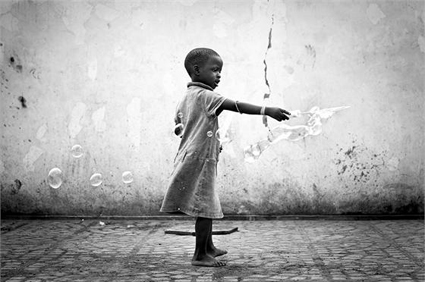
Tom Goldner, Volta
courtesy the artist
Tom Goldner, Volta
Photography is perhaps most associated with its power to bear witness to events—violent, confronting, humbling or inspiring—and there’s no shortage of documentary realism in Head On. Jimmy Pozarik has spent a year as photographer in residence at the Sydney Children’s Hospital, his images illustrating the devastating fragility of life. At the same gallery are Tom Goldner’s portraits of children from Lake Volta in Ghana, an area known for its human trafficking. The contrasting exhibitions create a complex dialogue about how young lives are valued. (Global Gallery Paddington, May 15-26; http://globalgallery.tumblr.com).
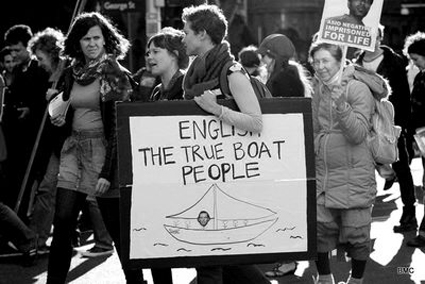
Barbara McGrady, Visions In Black & White: Images From Indigenous Australia
courtesy the artist
Barbara McGrady, Visions In Black & White: Images From Indigenous Australia
At Redfern Community Centre you can see Visions In Black & White: Images From Indigenous Australia by Barbara McGrady, a Gamilario/Murri woman who has been documenting contemporary Aboriginal life for 30 years. This exhibition features photos from the last three years including coverage of the Occupy Movement and significant Aboriginal cultural and music events. (Redfern Community Centre, May 10-June 30; http://www.cityofsydney.nsw.gov.au/explore/facilities/community-centres/redfern-community-centre)
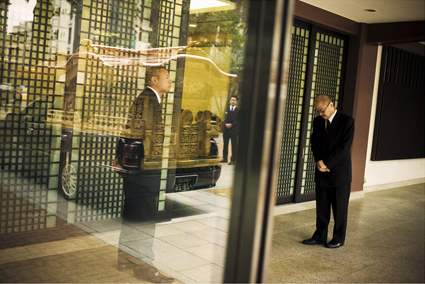
Anton Kuster, YAKUZA
courtesy the artist
Anton Kuster, YAKUZA
For a taste of the hyper-real gangster life, check out Anton Kuster’s photographic series which follows a Japanese Yakuza family for two years. (The Muse, TAFE Sydney Institute, May 18-June 22, http://www.sit.nsw.edu.au/)
performance
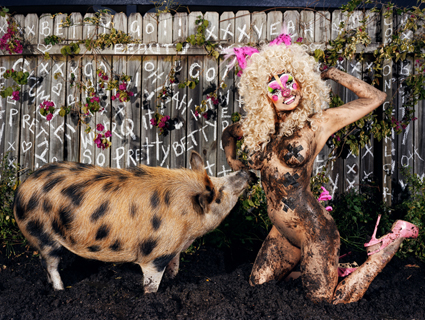
Dean Tirkot, Betty Grumble, 2013
courtesy the artist
Dean Tirkot, Betty Grumble, 2013
A number of exhibitions feature a playful use of the photographic medium, highlighting it as a tool for identity construction. At MOP Gallery Dean Tirkot has worked with “gender-ambiguous characters” including Glitta Supernova, Betty Grumble and Dallas Dellaforce. The images are captured on a large format 8×10” Deardoff field camera and are accompanied by texts by Welsh writer Wil Gritten. (MOP Gallery, May 9-26; http://www.mop.org.au/)
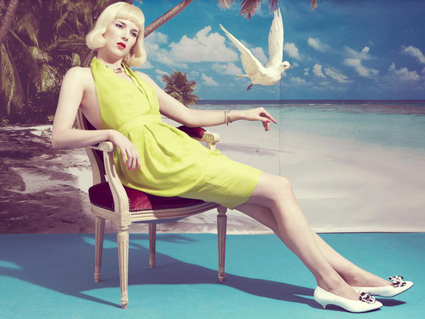
Kourtney Roy, Auto Myths
courtesy the artist
Kourtney Roy, Auto Myths
Canadian artist Kourtney Roy’s Auto Myths are nostalgic reconstructions, a “tragic mythology of the self, a personal universe where the prosaic is pervaded with the marvelous and strange” (website). Think Cindy Sherman meets Sophie Calle. (Customs House, Level 2 Library, May 15-July 15; http://www.cityofsydney.nsw.gov.au/explore/libraries/branches/customs-house-library)
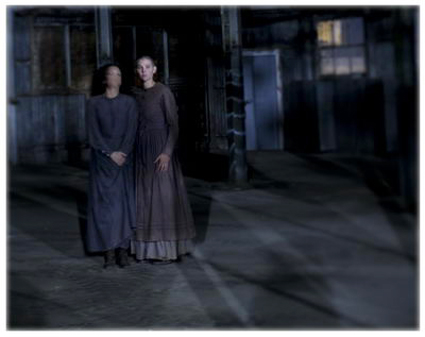
Cordelia Beresford, Presence
courtesy the artist
Cordelia Beresford, Presence
At Gaffa Gallery, filmmaker Cordelia Beresford continues her investigation of haunted spaces with Presence (see RT100). These photographs re-create imagined inhabitations of spaces such as a farm in Normandy used to house WWII prisoners and the reform school for girls on Sydney’s Cockatoo Island. (Gaffa Creative Precinct, May 30-June 8; http://www.gaffa.com.au/)
lo-tech
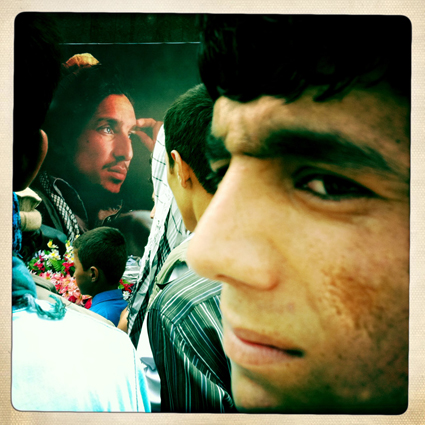
Ben Lowry, iAfghanistan
courtesy the artist
Ben Lowry, iAfghanistan
New developments in technology mean that everyone identifies as a photographer. Rather than fighting it some professionals are embracing the new democratising methods and testing their limits. In iAfghanistan, New York photographer Ben Lowry uses mobile phones and the free online Instagram App to explore life in Afghanistan. (State Library of NSW, Macquarie St. Foyer, April 28- July 27; http://www.sl.nsw.gov.au/)
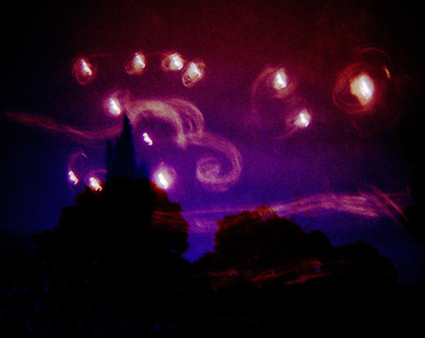
Tim Hixson, Starry starry night, Ludlites Love Music
courtesy the artist
Tim Hixson, Starry starry night, Ludlites Love Music
In the group exhibition Ludlites Love Music, artists such as Patrick Boland, Heleana Genaus and Steve Godbee use plastic cameras to create images inspired by popular song lyrics. (Bondi Pavilion Gallery, May 15-June 23; http://www.waverley.nsw.gov.au/things_to_do/arts_and_culture/gallery)
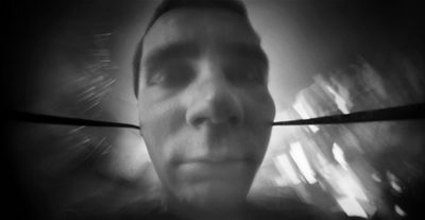
Jaroslaw Klups (2010), Pinhole Photo, Ghost Machine
courtesy the artist
Jaroslaw Klups (2010), Pinhole Photo, Ghost Machine
Taking an opposite approach, Ghosting Machine is a group exhibition featuring Australian and international artists, including Bronwyn Rennex, Aaron Seeto, Katthy Cavaliere and Jaroslaw Klups (Pol) presenting works made using 19th century techniques such as daguerreotypes, wet collodion prints and cyanotypes to create other worldly images. (Delmar Gallery, May 12-June 6; http://www.trinity.nsw.edu.au/4_community/socArts.html)
This is just a taste of the 80 featured exhibitions and 60 associated exhibitions as well as workshops, portfolio reviews and forums.
The best way to tackle the onslaught? Head on!
Head On Photo festival, various venues Sydney, launches May 17; see website for full info http://headon.com.au/
RealTime issue #114 April-May 2013 pg. web
© RealTime ; for permission to reproduce apply to realtime@realtimearts.net
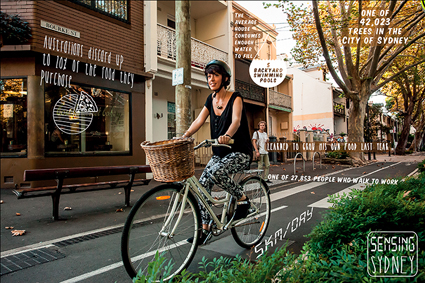
Sensing Sydney, Carbon Arts & the City of Sydney
sensing sydney, carbon arts, city of sydney
As part of Art & About 2013, Carbon Arts and the City of Sydney are looking to commission a temporary public artwork that somehow manifests data about sustainable living in Sydney—energy consumption, emissions, waste indicators, demographics etc. The aim of the work is to involve “the public in an active dialogue on environmental issues and citizen-engaged action” (website). All inclusive project budgets up to $25,000 will be considered.
Deadline 20 May
More info http://www.carbonarts.org/?post_type=projects&p=837
dramaturgy internships 2013
Sydney-based playwrights, directors or dramaturgs (emerging or more experienced) who are interested in learning more about script development are invited to apply for a six-month internship at Playwriting Australia. The successful intern will work regularly with the PWA team on script assessments and will be able to observe or assist with the National Script Workshops.
Applications close Monday May 20; http://www.pwa.org.au/dramaturgy-internships-2013
librettist workshop, chamber made
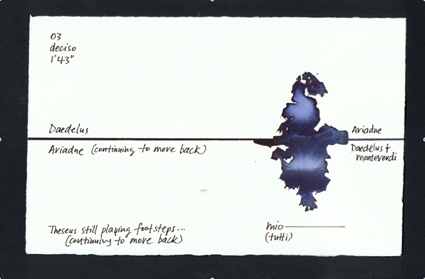
scrore from Minotaur The Labyrinth, David Young
Also on the writing front, Chamber Made Opera will be running a five-day workshop on the art of the libretto. There will be practical exercises as well as presentations by leading writers, librettists and dramaturgs Margaret Cameron, Alison Croggon, Brett Kelly, Angus Grant, Kate Schmitt and Chamber Made’s departing director David Young.
Chamber Made Opera, Writers Victoria, The Wheeler Centre, July 29- August 2; http://www.chambermadeopera.com/program/Librettists_Workshop
city of melbourne annual grants
Applications are now open for arts activities based in the City of Melbourne in 2014. Grants of up to $20,000 per applicant are available for the 2014 program.
Applications close 17 June 2013.http://www.melbourne.vic.gov.au/aboutcouncil/grantssponsorship/artsgrants/Pages/ArtsFunding.aspx
still in the loop
stephen cummins bequest residencies, performance space
Applications close June 3
http://www.performancespace.com.au/2013/stephen-cummins-2013-callout-queer-artists/
more…
beijing residency, 4a centre for contemporary asian art
Deadline May 31
http://www.4a.com.au/4a-beijing-residency-program/
more…
the sustainability of future bodies workshop series, isea2013, critical path
Applications due May 20: Apply online www.surveymonkey.com/s/ISEA13-CP-workshop-series
more…
workshops, networked art forms & tactical magick faerie circuits, cast
With Julian Oliver & Danja Vasiliev (May 31- June 2); Anne Goldeberg & Karine Rathle (June 5-8)
More info http://tacticalmagick.net/workshops
more…
call for percussion scores, campbelltown city council
Deadline for submissions July 1; www.campbelltown.nsw.gov.au/CallforScore
more…
travel fellowship, revelation, perth
Deadline 24 May
http://www.revelationfilmfest.org/go/travel/travel-fellowship
More…
arts house season 1, 2014
Deadline May 31
www.melbourne.vic.gov.au/ArtsHouse/fundinggrants/Pages/Fundingandgrants.aspx
More…
channels video art festival
Deadline June 1
More info www.channelsfestival.net.au/
More…
selected australia council grant deadlines
(for full list see http://www.australiacouncil.gov.au/grants)
Community Partnerships, due May 24
• Career Pathways – Professional Development
http://www.australiacouncil.gov.au/grants/2013/community-partnerships-career-pathways-professional-development-24-may
• Career Pathways – Fellowships
http://www.australiacouncil.gov.au/grants/2013/community-partnerships-career-pathways-fellowships
• Creative Producer
http://www.australiacouncil.gov.au/grants/2013/community-partnerships-creative-producer
• Projects
http://www.australiacouncil.gov.au/grants/2013/community-partnerships-projects-24-may
• Projects with Public Outcomes
http://www.australiacouncil.gov.au/grants/2013/community-partnerships-projects-with-public-outcomes-24-may
Visual Arts, due May 27
• Australia Council Visual Arts Laureate Award and Medal
http://www.australiacouncil.gov.au/grants/2013/visual-arts-laureate
• Creative Australia – New Work
http://www.australiacouncil.gov.au/grants/2013/creative-australia-new-work
Market Development, due May 31
• Visions of Australia and Contemporary Touring Initiative
http://www.australiacouncil.gov.au/grants/2013/visions-of-australia-and-contemporary-touring-initiative
• Playing Australia
http://www.australiacouncil.gov.au/grants/2013/playing-australia-31-may
RealTime issue #114 April-May 2013 pg. web
© RealTime ; for permission to reproduce apply to realtime@realtimearts.net
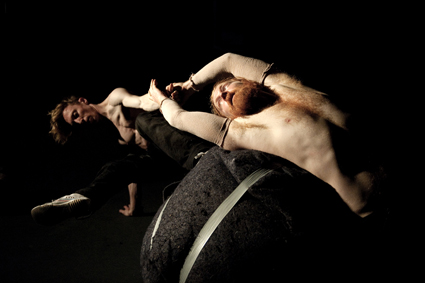
Skye Gellman, Kieran Law, Blindscape, La Boite Theatre Company (2013)
photo Sarah Walker
Skye Gellman, Kieran Law, Blindscape, La Boite Theatre Company (2013)
la boite indie, part 1
Each year Brisbane’s La Boite showcases works from a selection of emerging/underground/indie performance companies (whatever nomenclature you prefer). There’s not a traditional sit-down-and-shut-up audience experience among the first three shows currently showing. Sandra Carluccio’s This is Capital City lets the audience loose in Kelvin Grove charged with the mission to unearth the town’s myths with the help of some “city officials” and a mobile phone. The Séance by Mark Pritchard and Bridget Balodis invites the audience to a secret location where they will be complicit in the summoning of spirits. Blindscape, by Skye Gellmann collaborating with Kieren Law, turns the theatre space into an inhabited installation—the audience is guided through the performance via the Blindscape App supplied on entry. After the second Indie season later in the year audiences will be invited to vote for the performance they’d like to see remounted at QPAC in 2014.
La Boite Indie, May 8-25; http://laboite.qtix.com.au/laboiteindie2013/
lineage, form dance projects
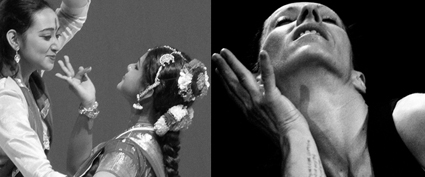
(left) Aruna Gandhimathinathan, Shruti Ghosh; (right) Tammi Gissell
photos (left) Annalouise Paul, (right) Lorna Sim
(left) Aruna Gandhimathinathan, Shruti Ghosh; (right) Tammi Gissell
Aruna Gandhimathinathan is trained in Bharatanatyam traditional Indian dance while Shruti Ghosh is predominantly trained in Kathak. They will be exploring the integration of these two forms in their collaborative dance work Nritya Roopa, accompanied by musician Prabhu Osoniq. Nritya Roopa is presented by Form Dance Projects as part of Lineage, a program investigating the intersections of traditional and contemporary practices. The evening also features emerging Indigenous choreographer Thomas ES Kelly working with Carl Tolentino on Dark Dreams, and a solo by Indigenous dancer/choreographer Tammi Gissell, A Dip for Narcissus.
Form Dance Projects, Lineage, May 23-25, Lennox Theatre, Riverside, Parramatta; http://form.org.au/2013/01/nritya-roopa/
anne landa award for video and new media arts 2013, agnsw
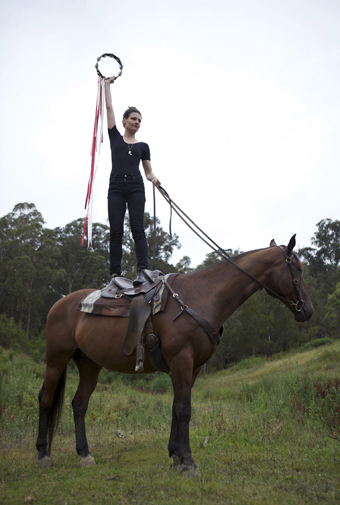
Lauren Brincat, Hight Horse (2012), documentation of an action, The space between us, Anne Landa Award for video and new media, AGNSW
courtesy the artist and Anna Schwartz Gallery
Lauren Brincat, Hight Horse (2012), documentation of an action, The space between us, Anne Landa Award for video and new media, AGNSW
Curated by Charlotte Day, the fifth iteration of the Anne Landa Award is themed “the space between us.” While video has always been at the forefront in this award, with perhaps the exception of Christian Thompson’s immersive sound installation, the media art component is less evident than usual this year, replaced it appears by performance. The video works by Laresa Kosloff, Angelica Mesiti, Kate Mitchell, James Newitt, Lauren Brincat and Alicia Frankovich are all based on perfomative actions and situations with the latter two artists also presenting live events over the course of the exhibition. Brincat’s performances will involve horse riding and mass timbrel playing, while Frankovich will present a jogging extravaganza. Perhaps a re-titling—the Anne Landa Award for Video and Performance Art—is in order?
Anne Landa Award for Video and New Media Arts 2013, May 16-Jul 28, Art Gallery of New South Wales; http://www.artgallery.nsw.gov.au/exhibitions/space-between-us/
everyday rebellions, gertrude contemporary
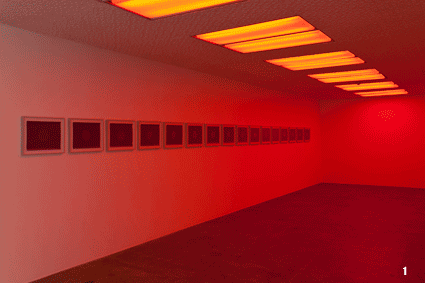
1) Dane Mitchell, The Smell of an Empty Space (Solid), 2011, Perfume, photographic paper, frame, courtesy Hopkinson Cundy and the artist, photo Sam Hartnett; 2 & 3) Kitty Kraus, Untitled, 2006, lamp, ice, ink, Courtesy of Galerie NEU, Berlin
In Gertrude Contemporary’s next exhibition it’s the objects that perform. Emily McCormack has curated a collection of works exploring the “innate activity of matter” and battlling the forces of entropy (website). For example Dane Mitchell’s photographs are “unfixed” and can only be viewed under the red lights of a darkroom, otherwise they fade to nothingness. German artist Kitty Kraus tracks the changing state from solid to liquid, her melting ink-ice puddling around a glowing light bulb for added tension. Also showing is Joan Jonas’ Vertical Roll, a video work from 1972 investigating the body in relation to the analogue glitches of the television screen.
Everyday Rebellions, Danica Chappell, Joan Jonas, Kitty Kraus, Dane Mitchell, Virginia Overell, Danae Valenza, Simon McGuinness, Gertrude Contemporary, Melbourne, May 11- June 8; http://www.gertrude.org.au/exhibitions/gallery-11/current-13/
suncorp twenties, sydney theatre company
You can’t accuse Cate Blanchett and Andrew Upton of losing touch with the average Australian—they know theatre tickets here are prohibitively expensive and they’ve actually found a solution. Brokering a deal with Suncorp, there will now be $20 tickets available for (nearly) all STC shows. You don’t have to be a student, pensioner, or under 30, you just have to try your luck on a Tuesday (via phone or in person at the box office) for the followings week’s shows. The partnership with Suncorp kicked off yesterday and will run for two years.
Sydney Theatre Company, Box Office 02 9250 1929; more info www.sydneytheatre.com.au
joachim koester, frances stark, ian potter museum of art
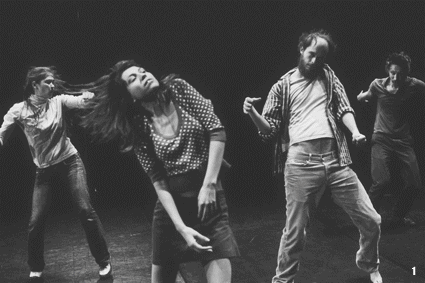
1 & 2) Joachim Koester, Tarantism, 2007, © & courtesy the artist and Galleri Nicolai Wallner, Copenhagen; 3 & 4) Frances Stark, My best thing, 2011, © & courtesy the artist and Marc Foxx, Los Angeles
If bitten by a tarantula in Medieval Italy it was believed dancing would cure you and thus the Tarantella was born. Danish artist Joachim Koester has recreated this frantic ritual in his 16mm film Tarantism currently screening for the first time in Australia, at the Ian Potter Museum. (Academic and dance historian Rachel Fensham will be giving a floor talk about the work on Thursday May 16.) Also screening is Frances Stark’s My Best Thing, a primitively animated feature which draws its content from the artist’s own interactions in the online environment Chatroulette.
Joachim Koester, Tarantism, Frances Stark, My Best Thing, Ian Potter Museum of Art, until June 2; http://www.art-museum.unimelb.edu.au/exhibitions/exhib-date/2013-03-20/exhib/joachim-koester-tarantism
stories then & now, performance 4a, carriageworks
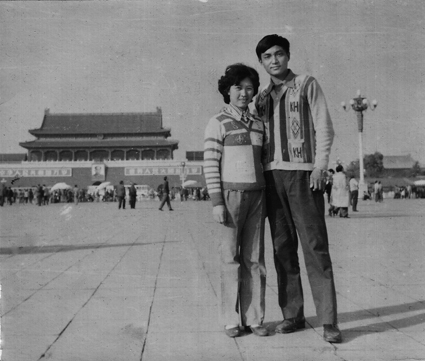
Stories Then & Now
courtesy Willa Zheng
Stories Then & Now
Photographer/raconteur William Yang and dynamic producer Annette Shun Wah have teamed up to co-direct this new theatre work focusing on the pasts and presents of six Asian Australians. The performance has developed out of Yang’s storytelling workshops and has been co-created with author Ien Ang, performer Jenevieve Chang, video journalist Michael C.S. Park, producer Sheila Pham, social worker/food writer Paul van Reyk and civil marriage celebrant Willa Zheng, with music by Nicholas Ng. Yang says “I think it is important for everyone to tell their story. It makes one conscious of self and it places one in the context of history, world and culture” (press release). Stories Then & Now is an umbrella event of the Sydney Writer’s Festival.
Stories Then & Now, presented by Performance4a & Carriageworks, May 22-25; http://www.performance4a.org.au/
goodbye jamie boyd, buzz dance & monkey baa
Goodbye Jamie Boyd is an interstate collaboration between two leading companies making performance for young people, Monkey Baa in NSW and Buzz Theatre in WA. Based on the verse novel by Elizabeth Fensham, the production uses movement, text and video design to evoke the story of a teenage girl fighting schizophrenia, haunted by the spectre of her deceased elder brother. After a successful NSW tour in 2012, Goodbye Jamie Boyd is now showing in Perth.
Goodbye Jamie Boyd, Buzz Dance & Monkey Baa, directed by Sandra Eldridge & Cadi McCarthy, Studio Underground, State Theatre Centre, Perth, May 15-25, http://www.buzzdance.com.au/productions.html#goodbye
still in the loop
direct democracy, muma
Monash University Museum of Art, until July 6
http://www.monash.edu.au/muma/exhibitions/upcoming/direct-democracy.html
more…
bloom—space, aeaf
Australian Experimental Art Foundation, Adelaide, until June 1
http://aeaf.org.au/exhibitions/21_bloomspace.html
more…
peter dailey, apparition: the syndicate ii
Fremantle Arts Centre until June 2; http://fac.org.au/events/288/peter-dailey-apparition-the-syndicate-ii?mid=12
more…
networked art forms & tactical magick faerie circuits, cast
Hobart, May 31-June 30;” http://tacticalmagick.net/
more…
conduit arts space initiative
May Music & Performance Program, Conduit Arts Initiative, Fitzroy
Full program http://conduitarts.wix.com/conduitarts#!program-music/ch3c
more…
diffuse, uts
May 23 & June 6, Bon Marche Studio, UTS
http://diffuse2013.wordpress.com/
more…
opal vapour, jade dewi tyas tunggal, mobile states
Adelaide, Perth, Hobart, Cairns, McKay, Brisbane, Canberra, Blacktown
May-June, see website for details http://performinglines.org.au/productions/opal-vapour/; http://opalvapour.com.au/
more…
gemeinboeck & saunders, velonaki, ingram, artspace
ISEA satellite exhibition, May 2-June 16 http://www.artspace.org.au/gallery_upcoming.php
more…
composition to movement festival, creative practice lab, unsw
May 24-26, part of Vivid Sydney
http://sam.arts.unsw.edu.au/c2m
more…
eve and eve, rebecca agnew, 24hr art
until June1
http://www.24hrart.org.au/
more…
hatched: national graduate show 2013, pica
until June 9
http://www.pica.org.au/
more…
no child, nilaja sun, theatre works
until May 26
http://www.theatreworks.org.au/whatson/event/?id=136
more…
shadowlife, bendigo art gallery
until July 28 http://www.bendigoartgallery.com.au/Exhibitions/Current_Exhibitions/Shadowlife
more…
RealTime issue #114 April-May 2013 pg. web
© RealTime ; for permission to reproduce apply to realtime@realtimearts.net
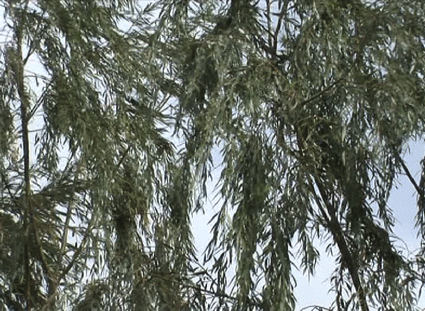
Wang Gongxin, Tonight Maybe Have Wind (2006), video stills
Down an alley between the small-scale old industrials of Fortitude Valley and into the new location of MAAP (Media Art Asia Pacific). Starting 15 years ago curating Asian-Pacific multimedia, Kim Machan’s MAAP has expanded into a gallery space, media resource centre and online repository of back catalogue(s) and other writings. A happy extension from curator to host.
The new space opened late last year with a solo show by Zhang Peili, who pretty much initiated video art in China with his 1988 video performance of repeatedly smashing a mirror, gluing it back together, smashing it again, regluing etc etc. Now MAAP is showing the other major pioneer of video art in China, Wang Gongxin, who installed and exhibited The Sky of Brooklyn—Digging a hole in Beijing in his own home in 1995, the first time video art was shown in Beijing.
Two works from Gongxin. The unfortunately named Tonight Maybe Have Wind (2006) is there as you enter—flat TV-sized monitor on the wall, a close-ish shot of swaying branches running in a repeated pattern of super-fast and ultra slow. Four minutes sped up and slowed down in such a way as to keep the ‘actual’ total duration unchanged. And there’s a subtle change synced to the image speed—the colour drops out to black and white, then slowly returns. Seems a bit of a formalist exercise on the representation of time through tech and I find myself struggling to get much of an aesthetic or intellectual buzz. I think about subjective time and attentional focus, the adaptive function of colour vision for an ape wanting to munch the ripest fruit and the freshest leaves but, nup, nothing. Ah well.
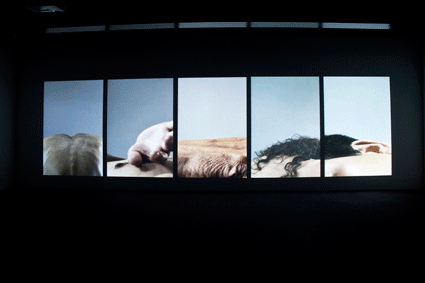
Wang Gongxin, Basic Colour (2010), installation view
photo Emily Nelson
Wang Gongxin, Basic Colour (2010), installation view
The other piece, Basic Colour (2010), provides an occasion for contemplation in formal simplicity and slowly changing fields of colour and sound. This work is much larger, five doorway-sized videos projected in a line onto a single wall. On the bottom third or so of each is a closeup of a body part—the back onto the shoulders, a hand reaching toward us, the side of another hand, the nape of the neck, a head on its side. Images are in sharp focus, abstracted by their size. Starts au naturel then pigment begins to fall onto each of the body parts—black on the shoulders, blue to the reaching hand, red to the side, yellow to the nape and white to the head. I cringe watching the ear slowly fill with white pigment. The sound is like rice falling onto card, a population of coherent noise emerging from thousands of individual grains. Then the pigment stops and water begins to softly fall and bead with the pigment. The beads join together, trickles form and colour runs down the body and away. And in moving from dry pigment to dripping water the sound slowly changes from falling rice to falling rain. Or maybe I’m imagining that change, the dominance of the visual forcing consistency between unchanging sound and changing image.
The body as land goes back forever. There are bodies of water, breast-named hills and bodies marked with ochre and ash. Gongxin shows that tradition and washes it away. The video loops and the tradition replays.
Wang Gongxin, MAAP Space, Fortitude Valley, Brisbane, March 22-May 3; maap.org.au; wanggongxin.com
Also check out http://www.maap.org.au/publications/, the recently launched online archive featuring 15-years of MAAP publications.
This article originally appeared as part of RT’s Online e-dition May 15, 2013
RealTime issue #115 June-July 2013 pg. 28
© Greg Hooper; for permission to reproduce apply to realtime@realtimearts.net
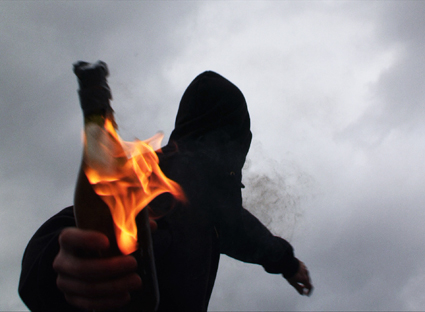
Informant
IF A HUMAN RIGHTS FILM FESTIVAL BRINGS TO MIND IMAGES OF PO-FACED, POORLY MADE ACTIVIST VIDEOS THEN THINK AGAIN.
Evolving from humble beginnings in 2007, the Human Rights Arts and Film Festival now profiles some of the most innovative documentaries from around the globe, along with a sprinkling of equally provocative dramas and exhibitions. On the eve of the festival’s sixth edition, Dan Edwards talked with programming manager Sari Braithwaite about her curatorial philosophy, and the sticky role of the arts in human rights debates.
First I’d like to ask what you see as the relationship between art and human rights? The relationship between them is not necessarily obvious.
The problem with human rights, particularly for Australians, is that they can often come across as common sense and be taken for granted. They can seem simple and not worthy of interrogation. That’s where the arts can come in and play with those ideas, let them be interrogated through storytelling and complicated by the everyday. Which is exactly what human rights discourse needs—it needs to be robust and fluid and people need to be part of the conversation, otherwise those rights run the risk of being taken for granted and not protected. So we are all about creating conversations and debate…a festival that has to balance issues with really great, innovative filmmaking. But the filmmaking really has to stand out, otherwise you lose people’s attention to the issue.
One of the things I found interesting about last year’s program was that documentaries like Planet of Snail, about a blind Korean writer, were wonderful films, but did not necessarily talk about human rights in an obvious or explicit way. How do you go about choosing films specifically for this festival?
What I loved about Planet of Snail (Seungjun Yi, Finland, Japan, South Korea, 2011) was that it was a beautiful story. By knowing these people you have insight into a disability that you don’t usually get—that’s the core right there. When you’re talking about human rights it’s not a particularly good idea to ram issues down people’s throats and to make the world seem hard, or problems seem unsolvable. It’s really important to show stories where people are empowered, where you see resilience, courage and ingenuity. Hopefully audiences walk out of the cinema and have a discussion, or maybe a fight about the film, then three months later maybe they have another discussion. That’s the kind of programming I really like to see happen. That’s why we put a large emphasis on guests, forums and post-screening events. People go in, see a film and they want dialogue.
So what do you think distinguishes HRAFF from something like the Antenna Documentary Festival in Sydney, or the big festivals like MIFF?
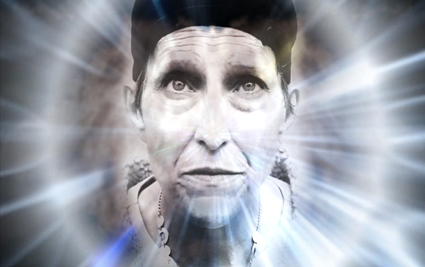
Walk Away Renee
I think HRAFF is a really good opportunity to reframe films—something like Planet of Snail is a good example—that you might not normally consider in the human rights context. This year we have Jonathan Caouette’s Walk Away Renee (USA/France, 2012), which is his follow-up to Tarnation (US, 2003). So much discussion about Jonathan Caouette focuses on how he plays with form, about how he was a first generation i-movie superstar filmmaker. But actually the relationship with his [mentally ill] mother in those films is really important and interesting in a human rights context. So we’re using Walk Away Renee to explore mental health, along with complex questions about representing mental illness on screen.
Although you feature some dramas, most of the films in the festival are documentaries. Is that a deliberate choice?
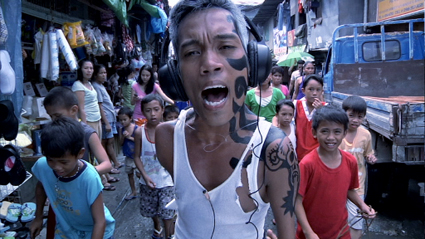
Mondomanila
Documentaries can be really powerful in exploring issues while telling a good story, but it’s also about what documentary filmmakers are interested in, because so many come from a social justice point of view. But as soon as there is an interesting narrative then I’m all for it. We’ve got Mondomanila (Khavn De La Cruz, Philippines, 2012) which is in exploitation film style—totally new territory for HRAFF, and really pushing our audience to think about what a human rights film is. It’s divisive, but it’s also really exciting to have those types of works in the program.
If you were asked to choose two or three films to see in this year’s program, what would you recommend?
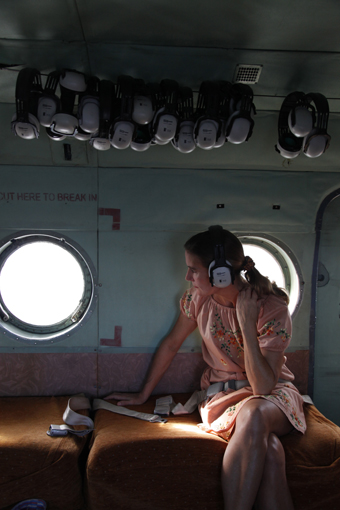
Alias Ruby Blade
The opening and closing night films this year are really special, and again there will be events around them. Alias Ruby Blade (Alex Meillier USA/Australia, 2012) is about Kirsty Sword, the young Melbourne woman who went to East Timor in the 90s, became part of the clandestine rebel movement there and started a relationship with Xanana Gusmão while he was in prison. So that’s a really great one for Australian audiences, because it connects us so closely with our nearest neighbours. For closing night, In the Shadow of the Sun (Harry Freeland, UK, 2012) is a really beautiful film about Josephat Torner—a man from Tanzania with albinism who travels the country trying to confront deep superstitions after a wave of murders of albinos.
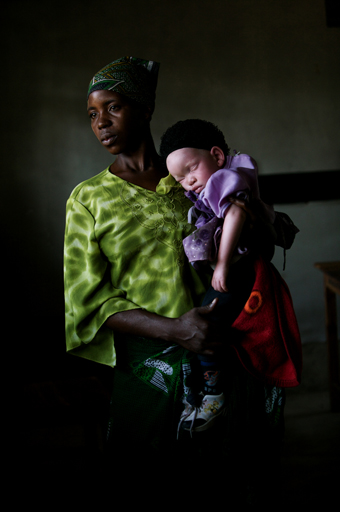
In the Shadow of the Sun
My narrative highlight has to be My Brother the Devil (UK, 2012), a coming-of-age story about two brothers living in the Hackney housing estate, from a first time British writer-director Sally El Hosaini. For documentary lovers, Informant (Jamie Meltzer, USA, 2012) is a really innovative exploration of how a leftist activist turned to work for the FBI. I’m also very proud of our Australian Shorts program, which showcases the astounding Silent Night (Best Film, Cockatoo Island Film festival, 2012, Margaret Lawrence Social Justice Award), a film about sexual assault by local filmmaker Bec Kingma.
It’s a diverse program. I think it’s really important in a human rights film festival to make people laugh and to feel a sense of joy and hope. It’s about showing what’s amazing, resilient and special about people in really tough situations—not just as victims, because then everyone’s disempowered, and I don’t think that’s what art is for. Art can help you re-frame and see things in different ways, and that’s exactly why HRAFF is so useful and important.
The Human Rights Arts and Film Festival, Australian Centre for the Moving Image, Melbourne, 9-23 May, http://hraff.org.au.
A selection of films will tour Sydney, Canberra, Perth, Brisbane and Alice Springs during May-June, see http://hraff.org.au for city programs.
RealTime issue #114 April-May 2013 pg. web
© Dan Edwards; for permission to reproduce apply to realtime@realtimearts.net
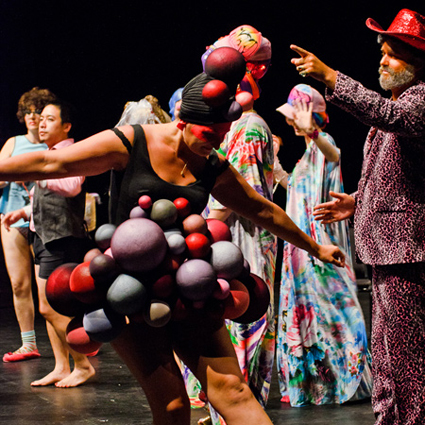
Stephen Cummins Bequest
photo Lucy Parakhina
Stephen Cummins Bequest
stephen cummins bequest residencies, performance space
The Stephen Cummins Bequest offers three emerging artists involved in queer performance a one-week intensive residency at Performance Space. The emphasis is on dramaturgical development within their practice with each artist working with a mentor. The residencies will take place in July with mentors Martin del Amo, Chris Ryan and Victoria Spence.
Applications close June 3; http://www.performancespace.com.au/2013/stephen-cummins-2013-callout-queer-artists/
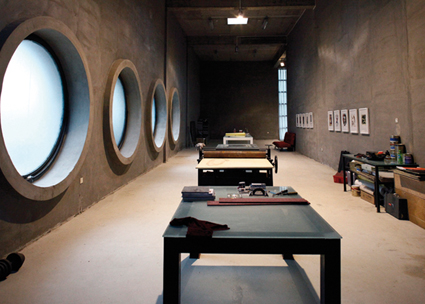
Shen Shaomin Studios, Beijing
beijing residency, 4a centre for contemporary asian art
Expressions of interest are now open for early career artists to apply for a one-month residency in the studios of renowned Chinese Australian artist Shen Shaomin (http://www.shenshaomin.com/). A project of 4a, the residency offers the opportunity to “research new projects in rich cultural surroundings, build networks and observe the changes taking place in one of the most important cities in the Asia region” (press release). The three successful applicants must be available to undertake the residency in September 2013.
Deadline May 31; http://www.4a.com.au/4a-beijing-residency-program/
the sustainability of future bodies workshop series, isea2013
As part of ISEA13 Critical Path is offering a series of workshops exploring the intersection between media and the body. Garth Paine will run a Motion Capture Open Lab (June 15-16); Paul Gazzola will explore The Dancing Body of the Future, Pt II, (June 18- 20); and in Writing, visiting French choreographer Myriam Gourfink will introduce her training and digital scoring methods. Ten NSW choreographers will receive an honorarium to attend.
Applications due May 20: Apply online www.surveymonkey.com/s/ISEA13-CP-workshop-series
workshops, networked art forms & tactical magick faerie circuits, cast
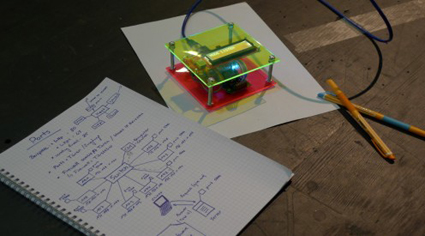
weise7.org
In Hobart, the Networked Art Forms… festival (see quick picks) includes two intriguing hands-on workshops. Hacker masters Julian Oliver (NZ/GER) and Danja Vasiliev (RUS/GER) will run a Networkshop (May 31- June 2) which will bring the communication tools of the digital age back under the user’s control recreating a small-scale version of the internet. Anne Goldeberg (FRA/CAN) and Karine Rathle (CAN) will run Attent!ion Som(t)a(c)tic (June 5-8) to examine participants’ physical relationship with their communication tools and “explore avenues of creative empowerment by suggesting techno-humanist thematic improvisations” (press release). The workshop will culminate in a multimedia installation and performance.
More info http://tacticalmagick.net/workshops
backbone 2high festival 2013
The annual 2High Festival in Brisbane not only supports emerging artists but also emerging producers. The festival is looking for keen young things (18-26) who are interested in becoming part of the team that makes this multi-disciplinary event happen. The festival will take place Nov 2 at the Brisbane Powerhouse.
Deadline May 17; http://www.backbone.org.au/2high-festival.cfm
call for scores, campbelltown city council
Submissions are invited for musical compositions written for a single percussion instrument or “defined group of instruments originating from the same family” (website). Successful compositions will be premiered by leading percussionist Claire Edwardes at Campbelltown Arts Centre in November.
Deadline for submissions July 1; www.campbelltown.nsw.gov.au/CallforScore
still in the loop
the 2013 hive production fund
Deadline May 13
more info http://www.adelaidefilmfestival.org/default.asp?contentID=353
More…
proximity festival 2013
Deadline May 17
http://proximityfestival.com/
More…
travel fellowship, revelation, perth
Deadline 24 May
http://www.revelationfilmfest.org/go/travel/travel-fellowship
More…
arts house season 1, 2014
Deadline May 31
www.melbourne.vic.gov.au/ArtsHouse/fundinggrants/Pages/Fundingandgrants.aspx
More…
channels video art festival
Deadline June 1
More info www.channelsfestival.net.au/
More…
selected australia council grant deadlines
(for full list see http://www.australiacouncil.gov.au/grants)
Literature, due May 15
• New Work – Digital and New Media,
http://www.australiacouncil.gov.au/grants/2013/literature-new-work-digital-and-new-media
Community Partnerships, due May 24
• Career Pathways – Professional Development
http://www.australiacouncil.gov.au/grants/2013/community-partnerships-career-pathways-professional-development-24-may
• Career Pathways – Fellowships
http://www.australiacouncil.gov.au/grants/2013/community-partnerships-career-pathways-fellowships
• Creative Producer
http://www.australiacouncil.gov.au/grants/2013/community-partnerships-creative-producer
• Projects
http://www.australiacouncil.gov.au/grants/2013/community-partnerships-projects-24-may
• Projects with Public Outcomes
http://www.australiacouncil.gov.au/grants/2013/community-partnerships-projects-with-public-outcomes-24-may
Visual Arts, due May 27
• Australia Council Visual Arts Laureate Award and Medal
http://www.australiacouncil.gov.au/grants/2013/visual-arts-laureate
• Creative Australia – New Work
http://www.australiacouncil.gov.au/grants/2013/creative-australia-new-work
Market Development, due May 31
• Visions of Australia and Contemporary Touring Initiative
http://www.australiacouncil.gov.au/grants/2013/visions-of-australia-and-contemporary-touring-initiative
• Playing Australia
http://www.australiacouncil.gov.au/grants/2013/playing-australia-31-may
RealTime issue #114 April-May 2013 pg. web
The micro and macrocosm of human interaction; imagined landscapes, invented instruments; and the sulphurous whiff of network magic in the air…
moving image i, critical path artists’ salon
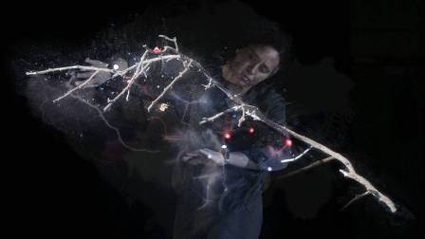
Sam James, From the Rainforest Mind to the Desert Mind featuring dancer Victoria Hunt (video still)
courtesy the artist
Sam James, From the Rainforest Mind to the Desert Mind featuring dancer Victoria Hunt (video still)
Over 2013 Critical Path will be hosting a series of salons comprising artist presentations and discussions. The first of these, curated by choreographer/filmmakers Narelle Benjamin and Sue Healey, promises “experiments with movement within interdisciplinary practice” (website). It includes a multi-screen 3D video installation by Sam James, From the Rainforest Mind to the Desert Mind, featuring dancer Victoria Hunt; and a performative remake of Guy Sherwin’s 1976 Man with Mirror (in which he interacted live with his onscreen image) by Louise Curham and Lucas Ilhein re-titled (Wo)man with Mirror.
Moving Image I, Critical Path, Sydney, May 11, 4pm (open studio from 3pm); http://moving-image1-2013.eventbrite.com/
direct democracy, muma
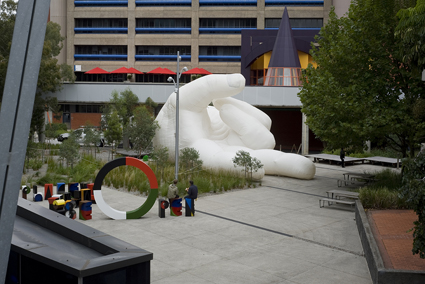
Carl Scrase, The Generative Power of Opposites (2009)
courtesy the artist
Carl Scrase, The Generative Power of Opposites (2009)
Direct Democracy reflects on recent eruptions of people power such as the Arab Spring and the Occupy movement. Curated by Geraldine Barlow it includes 20 international and Australian artists such as video artist Natalie Bookchin (USA), curious object creator Will French (AUS) and the collaborative action project A Centre For Everything. There are also workshops such as collaborative drawing using the DAMP Collective’s giant pencil and forums including a look at the student protests at Monash in the 1960s. You’ll know that you’re close to the gallery when you spy Carl Scrase’s giant inflatable hand—you can decide whether it’s giving you a peace sign or an “up yours.”
Monash University Museum of Art, until July 6; http://www.monash.edu.au/muma/exhibitions/upcoming/direct-democracy.html
bloom—space, aeaf
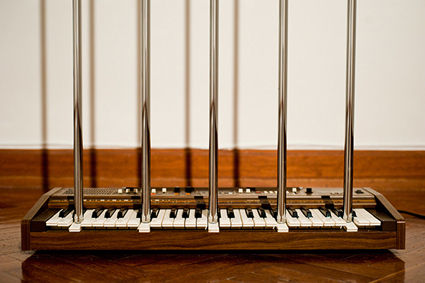
Julian Day, twinversion: Lovers (detail), 2012, dimensions variable
photo Emily Sandrussi
Julian Day, twinversion: Lovers (detail), 2012, dimensions variable
While Direct Democracy looks at the big picture of human interaction, the next exhibition at AEAF looks at intimate exchanges, mainly between objects. Curated by Adele Sliuzas, the works include a growing field of grass by Carla Liesch, a pair of keyboards physically locked in a drone dual by Julian Day, objects in curious inter-relations by Roy Ananda and Will French and video work by Lisa Harms.
Australian Experimental Art Foundation, Adelaide, until June 1; http://aeaf.org.au/exhibitions/21_bloomspace.html
undone, arts house
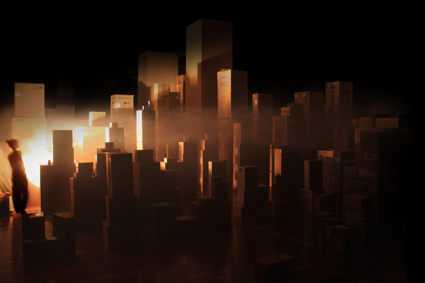
Lara Tumak, Before I Fell Asleep
courtesy the artist
Lara Tumak, Before I Fell Asleep
Last loop we highlighted Metro Arts Friday Night program which opens the rehearsal room doors to reveal the creative processes taking place in the building. This week it’s Arts House’s turn to bare all with their Undone program. Arts House invests significantly in the creative development of projects, in particular through its CultureLAB program. For one afternoon audiences can catch glimpses of potentially full-scale productions. Artists include Natalie Abbott, Angus Cerini, Mish Grigor, Deborah Leiser-Moore, Brian Lipson and David Woods, Tamara Saulwick and Lara Tumak.
Arts House, Meat Market & North Melbourne Town Hall, May 11, 12-6pm; http://www.artshouse.com.au
paul dresher, double duo?
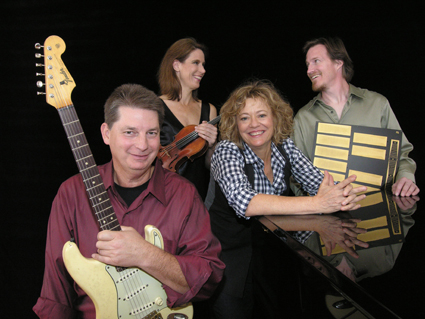
Double Duo
photo Nina Roberts
Double Duo
The music of US composer Paul Dresher incorporates West Coast Minimalism with Northern Indian and Balinese influences. To fulfill his compositional needs he has invented his own instruments. The Quadrachord is a long stringed instrument that can be bowed, plucked and hit. The Marimba Lumina is an electronic percussion instrument. (See these instruments in action here.) He will present two concerts in Sydney with his group Double Duo—Dresher, Joel Davel, Karen Bentley Pollick and?Lisa Moore—performing his own compositions along with works by John Adams and Martin Bresnick.
Music Workshop, Sydney Conservatorium of Music, Sydney May 9, http://www.cityrecitalhall.com/events/id/1447/Paul-Dresher-Double-Duo/; Campbelltown Arts Centre, May 11, 8pm, www.campbelltownartscentre.com.au
film real—black screen, nfsa & footscray arts centre
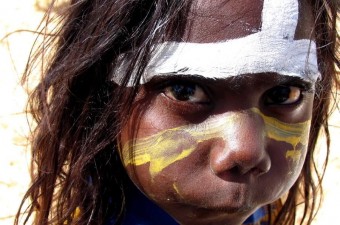
Our Generation, Sinem Saban & Damien Curtis, Black Screen, National Film & Sound Archive
The National Film and Sound Archive’s Black Screen Initiative offers DVDs of contemporary Australian Aboriginal features, documentaries and shorts to individuals and organisations for public screenings. As part of their Film Real series Footscray Arts Centre will be screening the documentary Our Generation (Sinem Saban & Damien Curtis, 2010) which looks at the plight of the Yolgnu people in the Northern Territory whose human rights have been eroded by white governance.
Film Real, Black Screen, Our Generation, Footscay Arts Centre, May 14, 6.30pm; http://footscrayarts.com/access-blog-event/film-real-black-screen-may/; http://www.ourgeneration.org.au/
peter dailey, apparition: the syndicate ii, fremantle arts centre
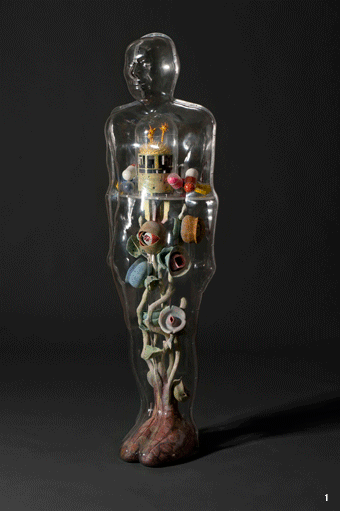
Peter Dailey, Apparition (2013): 1) Alchemist, collection of Ron and Sandra Wise; 2) Ruminate, collection of Jan Spriggs and Perry Sandow; 3) Meek, collection of Graham and Vicki Teede; 4) Abnegate, collection of Jan Spriggs and Perry Sandow
photo Eva Fernandez
Peter Dailey, Apparition (2013): 1) Alchemist, collection of Ron and Sandra Wise; 2) Ruminate, collection of Jan Spriggs and Perry Sandow; 3) Meek, collection of Graham and Vicki Teede; 4) Abnegate, collection of Jan Spriggs and Perry Sandow
The Syndicate is an innovative philanthropic project initiated by art patron Lloyd Horn in which a group of collectors supports an artist for two years enabling them to create a body of work. The second artist commissioned by the Syndicate is Peter Dailey who has created Apparition, a series of 10 life-size human figures that evoke the “cultural, economic, political and environmental mechanisms” involved in being human (website). The Apparition is currently on show at the Fremantle Arts Centre.
Peter Dailey, Apparition: The Syndicate II, Fremantle Arts Centre until June 2; http://fac.org.au/events/288/peter-dailey-apparition-the-syndicate-ii?mid=12
networked art forms & tactical magick faerie circuits, cast
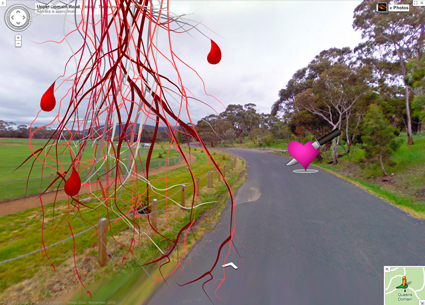
Linda Dement, KILL FIX
courtesy the artist
Linda Dement, KILL FIX
The ISEA13 media art lovefest is not just concentrated in Sydney. Networked Art Forms & Tactical Magick Faerie Circuits is a satellite event in Hobart’s CAST as part of DARKMOFO, developed by Miss Despoinas (a hacker space headed by Nancy Mauro-Flude). The event focuses on “maker” cultures adopting “a radical holistic approach to digital culture” (press release). There will be a three-day feast of workshops, talks and forums (May 31-June 2) with resulting ideas developing into a series of events June 3-30. Participating artists include Linda Dement (AUS), Francesca da Rimini (AUS), Mez Breeze (AUS), Florian Cramer (GER/NL) and Julian Oliver (NZ/GER). (See our in the loop opportunities page for workshop details).
Networked Art Forms & Tactical Magick Faerie Circuits, CAST, Hobart, May 31-June 30;” http://tacticalmagick.net/
conduit arts space initiative
Artist-led space Conduit Arts, a shopfront in Fitzroy, has a rather novel programming structure. For one month it focuses on visual arts, the next on music and performance, and in May it’s music’s turn. There will be a whopping 15 performances over a month of improvised and experimental music and poetry with artists such as Dale Gorfinkel, Robie Aveniam, Simon Charles, Jessica Wilkinson, Ida Duelund-Hansen, Mark Cauvin and Matthias Schack-Arnott.
May Music & Performance Program, Conduit Arts Initiative, Fitzroy, full program http://conduitarts.wix.com/conduitarts#!program-music/ch3c
diffuse, uts
Produced by Jon Drummond in association with the Sound and Music Design course at UTS, Diffuse is a program of music performances in May and June. The first concert focuses on spatial diffusion and will see Isobel hemisphere speakers used in the Bon Marche for the first time. Performers across the series include Zane Banks & Benjamin Carey, Julian Day, Daniel Blinkhorn, Michael Atherton & Jon Drummond, Alon Asar, Roger Mills, Peter Hollo, Gail Priest and David Miller.
Diffuse, May 9, 23 & June 6, Bone Marche Studio, UTS; http://diffuse2013.wordpress.com/
still in the loop
opal vapour, jade dewi tyas tunggal, mobile states
Adelaide, Perth, Hobart, Cairns, McKay, Brisbane, Canberra, Blacktown
May-June, see website for details http://performinglines.org.au/productions/opal-vapour/; http://opalvapour.com.au/
more…
gemeinboeck & saunders, velonaki, ingram, artspace
ISEA satellite exhibition, May 2-June 16 http://www.artspace.org.au/gallery_upcoming.php
more…
composition to movement festival, creative practice lab, unsw
May 24-26, part of Vivid Sydney
http://sam.arts.unsw.edu.au/c2m
more…
eve and eve, rebecca agnew, 24hr art
until June1
http://www.24hrart.org.au/
more…
living in the ruins of the 21st century, uts gallery
until May 17
http://livingintheruins.net; http://www.art.uts.edu.au/gallery/current/current.html
more…
hatched: national graduate show 2013, pica
until June 9, Digital Now, May 8
http://www.pica.org.au/
more…
natalie abbott, physical fractals, pact
Until May 10
http://www.pact.net.au/2013/04/month-of-dance/
more…
no child, nilaja sun, theatre works
until May 26
http://www.theatreworks.org.au/whatson/event/?id=136
more…
shadowlife, bendigo art gallery
until July 28 http://www.bendigoartgallery.com.au/Exhibitions/Current_Exhibitions/Shadowlife
more…
uta uber kool ja, army of love, judith wright centre
May 8-18
http://judithwrightcentre.com/event/uta_uber_kool_ja
more…
RealTime issue #114 April-May 2013 pg. web
© RealTime ; for permission to reproduce apply to realtime@realtimearts.net
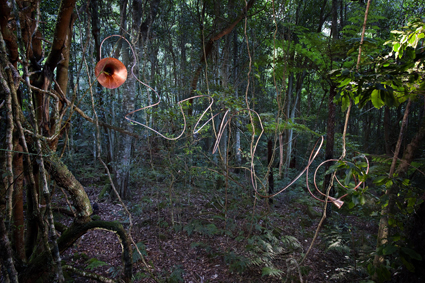
Darragh O’Callaghan, Serosa , Sculpture at Scenic World
photo Keith Maxwell
Darragh O’Callaghan, Serosa , Sculpture at Scenic World
To get down into Jamieson Valley, Katoomba (NSW), you can hike or you can head to Scenic World and experience the vertiginous descent via cable car or the newly refurbished Scenic Railway. Once in the valley you are in a rainforest that dates back to the Jurassic period, which is breathtaking enough, but throughout May you could also experience an impressive sculpture exhibition featuring 35 works installed amid the undergrowth.
The rainforest offers amazing potential as a gallery but also its share of challenges. The artworks have to be transported down into the valley before the ‘doors’ are open to the daily tourist trade. Meanwhile, installing artwork in a World Heritage-listed environment presents its own issues. Exhibition Manager Lizzie Marshall tells me the project aims to have a zero ecological impact which involves minimising soil compression and engaging specialist arborists to suspend works above the forest floor.
Marshall decides on the placement of the works along the walk, describing them as site-responsive rather than site-specific. Since the event is a competition, the works are generally conceived at submission stage; however, each artist may subtly tailor the work to their location. The sites themselves may also undergo change—within a month, trees fall, saplings grow, leaves and bark are shed, altering the composition of the environment. The most intriguing pieces are those that work with elements of their site but also maintain otherness.
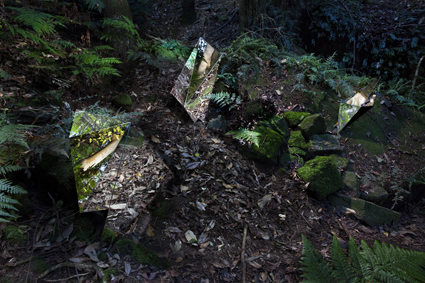
Daneil Kotja, Reflect Phi (a monument), Sculpture at Scenic World
photo Keith Maxwell
Daneil Kotja, Reflect Phi (a monument), Sculpture at Scenic World
The winning sculpture by Blue Mountains artist Daniel Kotja best exemplifies this liminal state. Reflect Phi (a monument) uses the geometrical principle of Phi, which recurs in the growth cycle of plants, as the basis for the work. The sleek, multi-angled objects made from highly polished stainless steel are clearly at odds with the irregular curves of the natural world. However the mirrored surfaces reflect the environment in shifting planes, softening the sharp edges and creating a confounding dimensionality to the object. Via these reflections the sculpture both takes from and gives back to the site.
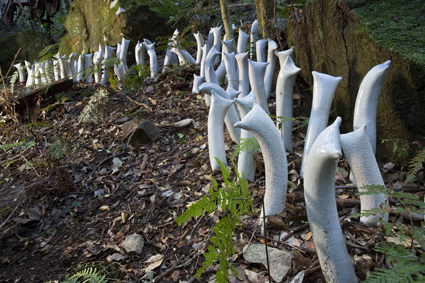
Kimie Kitamura, Get Together!, Sculpture at Scenic World
photo Keith Maxwell
Kimie Kitamura, Get Together!, Sculpture at Scenic World
Kimie Kitamura (NSW) also exploits this otherness with Get Together! Along a ledge, nestled amongst the leaves and short grasses is a collection of off-white porcelain tubes. Without any features their shape hints at cartoonish life forms with limb-like peaks (or are they ears?). Arranged in clumps, they appear to incline towards each other as though communing. Their greyish hue and multiplicity also suggests emerging mushrooms and the teeming micro-life below the soil. Blue Mountains artist Linda Seiffert’s ceramic creation, Undulating Form, also brings to mind the wonders of the fungal world with its interlocked twisting surfaces finished in a dusty, deep ochre, embedded in the humus. This work really looks as though it could have grown here.
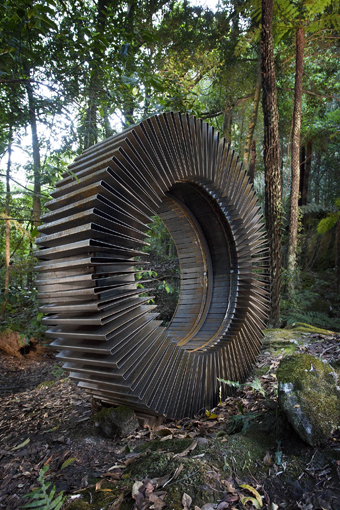
Al Phemister, Kern, Sculpture at Scenic World
photo Keith Maxwell
Al Phemister, Kern, Sculpture at Scenic World
The valley also bears the imprint of industry: chunks of old machinery from old cable cars and mining ventures scattered among the trees. Left Behind, by Penny Philpott (NSW), comprises perfect ceramic replicas of rusty chains lying in piles and snaking off through the undergrowth. Kern, by Al Phemister (NSW), is a large-scale cog made from folded black steel, already bleeding rust. Both are well placed at the end of the walk near the cable station, highlighting the rich layering of the environment—organic, machinic, historic, touristic, artistic.
Now in its second iteration the exhibition also includes a number of media works. A video installation, ex/enclosure, by Blue Mountains’ artist Sarah Breen-Lovett is perhaps the only truly site-specific piece. The artist has filmed light seeping in through the cracks in an old miner’s cottage. These minimal white slashes are flipped vertically and projected back onto the hearth of the hut. While relatively simple, it’s a conceptually complete use of the space. Another development this year is Sculpture Otherwise, a small exhibition in the tourist centre of maquettes and samples which show sculptural detailing close-up.
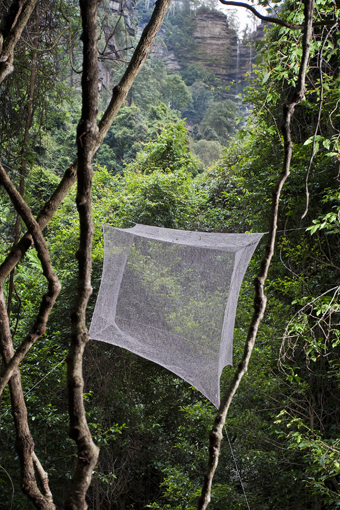
Greer Taylor, resting place, Sculpture at Scenic World
photo Keith Maxwell
Greer Taylor, resting place, Sculpture at Scenic World
Exhibiting 35 outdoor sculptures in such a complex and ever changing environment is certainly an impressive feat. What is most striking is how, by careful site-choices, the works draw you further into the natural environment. The twist of copper tubing in Irish artist Darragh O’Callaghan’s Serosa reflects the tangled root structures of the trees around it. The fringes of Victorian artist Kallie Turner’s Josephus, an intricate “forest keepers” garment, alerts you to the curtains of shredded bark up above. NSW artist Greer Taylor’s Resting Place, a suspended trapezoid of hand-knitted copper wire, intensifies the shifting shafts of light through the canopy. In this way the exhibition is particularly successful in its integration of the human-crafted object and the organic environment. And indeed it succeeds in the more pragmatic integration of art and tourism as well.
Sculpture at Scenic World, exhibition manager Lizzy Marshall, Katoomba, April 24-May 19, http://www.scenicworld.com.au/experiences/sculpture/
Gail Priest was a guest of Scenic World and the Carrington Hotel, Katoomba.
This article originally appeared in RT’s online May15 e-dition
RealTime issue #115 June-July 2013 pg. 56
© Gail Priest; for permission to reproduce apply to realtime@realtimearts.net
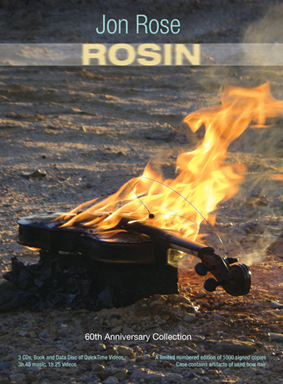 CD review
CD review
ReR (ReRJR60)
www.rermegacorp.com
Jon Rose has done much with and to the violin, and upon hearing this CD a great deal more than you might have ever imagined. For listeners unfamiliar with his music, Rose’s new CD opens a door to his unique engagement with the instrument and with sound and its place in our world. For those who love his work it is a collector’s item.
Rosin (the CD is named after the stuff you rub on the bow to change its texture and enrich the sound of the violin strings) comprises CDs, a disc of videos and a booklet discussing the selected works with testimonies by David Harrington, Richard Barrett and others on the nature and immensity of Rose’s contribution to music. Subtitled “A 60th Anniversary Collection,” it was released shortly after this milestone birthday and with three hours 45 minutes of music and an hour and 25 minutes of visual material, it’s an excellent introduction to his recent work. Presumably it’s a personal retrospective, emphasising favourite developments. Though less comprehensive than his webpage, it focuses on specific projects: his Pannikin series of recordings of people making all kinds of sound (a subset of the ABC’s Australia Ad Lib series), his fence-playing, his electronic interventions into the violin and his ball-games and bicycle series.
Rose’s work questions our assumptions not only about music, sound and performance but about the world in which we live. His Garage Fence project, in which he set up four fences like a boxing ring, to be played on stage by Kronos Quartet, is about more than just making fencing-wire vibrate interestingly (though he is always looking for objects that make interesting sounds). Miking a fence for sound interrogates its resonant properties and reveals its metaphorical harmonics. For example when he plays the Dingo Fence he draws our attention to its environmental significance and to the concepts of containment and border. Turning a fence into a musical instrument disrupts its emblematic power. He has performed at the USA-Mexico border and the Separation Fence in the Israeli Occupied Territories, challenging their authority. He engages with the outback—Oodnadatta, the Strzelecki Desert, Wogarno Station—as a mystical, alien, forbidding, even sacred world. Rose is a philosopher and social commentator and his philosophical investigations often start as musical or sonic ones.
Rose encourages people to make sound and one of his most important endeavours, collecting home-made sounds, is given due attention on the CD. There are samples from the Pannikin Project, in which Rose invited do-it-yourself musicians to demonstrate their work and remixed it with his own accompaniment—for example recordings of a shopkeeper repeatedly singing “Thank you very much,” gum-leaf players mimicking bird calls, a whip-cracker, an auctioneer in full cry, a chainsaw orchestra (protesting against logging) and the only department store pianist still working. The Pannikin Project redefines musical performance and acknowledges under-recognised aspects of our culture. Rose’s attitude to sound is highly democratic—anyone can (and should) participate; there’s no distinction between high and low art, and it’s fun!
Rosin includes an excerpt from his radio documentary Syd and George about a lyrebird, with string accompaniment suggesting the kinds of sounds naturally made by the bird, highlighting the concepts of mimicry and sonic representation. We anthropomorphise the lyrebird as a musician, but ironically it is itself a recorder that reproduces samples of sounds it has heard.
There are selections from Rose’s musical performances involving combinations of improvised and notated sound for various ensembles. The high-powered concerto Internal Combustion is scored for improvised violin (dazzlingly played, including fragmentary quotes from Tchaikovsky) and an ensemble playing from a detailed, conventionally notated score, challenging the conventions of concerto composition and performance. There is an excerpt from Charlie’s Whiskers, commissioned from Rose by Slovakian composer Daniel Matej, in which Rose creates competing musical palindromes to pay homage to Charles Ives’ approach to composition. (See RT112 for other Rose/Matej collaborations)
Digger Music is scored for an excavator whose movements are electronically mapped to generate signals that are blended with other sounds including improvised violin. Talking Back to Media, a variant on talk-back radio, employs musicians, a poet and a sound artist and includes samples of horse-race commentary. Multiple competing sound sources represent inner and outer reality—this piece is sonically complex, musical and fascinating.
RRose experiments endlessly with the violin: Violin 3D Model uses a ‘K bow,’ electronically engineered to enable control of sonic output through angle, stroke length and other parameters. In Palimpolin (the title condenses ‘palimpsest’ and ‘violin’), he again uses a modified bow to control sampling, pitch shifting and mediation of the final sound. Such an instrument offers a single performer a sound palette of orchestral proportions. Then there is his Viocycle, a bicycle rigged so that, when moving, it drives a mechanism that engages the strings of a violin mounted to the frame, like a mobile hurdy-gurdy—the player controls the sound by riding at different speeds. Imagine a peloton orchestra!
The CD is well produced and, strangely, CD2 and 3 conclude with an extra track not cited in the booklet, provoking intense curiosity. The secret track on CD2 sounds like a modified cello wonderfully played. The CD3 mystery track is an absorbing melange of amplified, mediated instruments and objects.
On the disc of QuickTime videos is a sample of Rose’s Ball Project which introduces his experiments with volleyballs, rugby-balls and the like to generate sound, thus engaging with society’s obsession with ball-sports and extending his audience for sonic experimentation. Rose fits the balls with sensors that, when in play, send signals to computers that produce audio-visual material, linking the resulting sounds with the player’s actions and shifting the emphasis from winning to music-making. The video on this CD is of a concert audience tossing around a giant beach-ball and enjoying the noises they generate, the ball-game inducing collective activity and awareness.
Most significantly, there is a video of Jon Rose burning to ash a closely-miked violin, an apparently iconoclastic act, perhaps even a strange ritual of renewal. This unique sight and sound of a violin’s cremation is romantically set in the outback at dusk. In fact, there can be no more committed, inventive or insightful experimental composer, sound artist, musician and philosopher of music than Jon Rose, and his impact is worldwide. He continually challenges us and draws us into a world of sound that turns out not only to be accessible but fun and a stimulus to our own creative exploration. While his work betrays the highest level of musicianship, it tells us to listen more attentively to the world and to think more deeply about what sound and music are and what they mean to us.
Chris Reid
Many of Jon Rose's projects are documented here http://www.jonroseweb.com
See Jon Rose in conversation with Jim Denley in our RealTime TV interview
RealTime issue #115 June-July 2013 pg. 46
© Chris Reid; for permission to reproduce apply to realtime@realtimearts.net
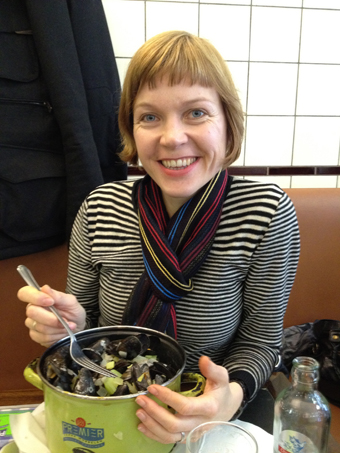
Sophie Travers eating moules (mussels)
courtesy Sophie Travers
Sophie Travers eating moules (mussels)
reason for travelling
Living in Brussels for 18months as the Project Manager, IETM (International Network for Contemporary Performing Arts) Australia Council Collaboration Project.
that art attraction
It is not for no reason that expatriate artists from around the world gravitate to Brussels. Second only to Berlin for easy living and arts stimulation, Brussels is a mecca for performing arts in particular. The healthy competition between the Flemish and Wallonian communities that share the capital leads to a disproportionate number of arts institutions, festivals and events. The fact that the arts funding system remains relatively generous at a time when large swathes of Europe are going belly-up adds to Brussels’ attractions for international artists, as do the non-discriminatory criteria for who can gain access to funding and benefits.
The geography of Brussels is one of its major strengths, as it sits an easy 90 minutes from Paris on the train, 30 minutes from Lille, two hours from London and Amsterdam and six from Berlin. The confluence of countless European networks with their headquarters in Brussels (not least IETM), creates many opportunities for artist mobility and most of the Belgian presenters are part of schemes that ensure the best international programming finds its way to Brussels sooner or later. Brussels’ laid back, slightly chaotic feel is one of the things that surprised me most and I have greatly enjoyed exploring the multicultural mix of the many neighbourhoods that make up the city. Eating and drinking in Brussels is superb and affordable too. Shame that the skies seem to be grey for ten months of the year.

for culture
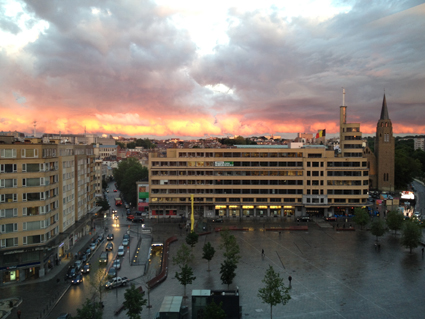
Place Eugène Flagey, Brussels
photo Sophie Travers
Place Eugène Flagey, Brussels
Brussels is awash with impressive arts institutions and some of the big ones represent the best that Europe can offer. BOZAR, in the city centre, is a multi-faceted space with an enticing gallery offering big artists like Watteau and smaller, commissioned studio activities, often themed around EU projects such as the Francis Bacon exhibit to celebrate the current Irish Presidency of the EU. BOZAR programs contemporary, world and classical music in venues that also host theatre and dance. As is the case with most Belgian arts houses, the offer for families is extraordinary and we have relished the regular Sunday morning programming for kids as well as the themed Family Days.
Kunstenfestivaldesarts is the annual performing arts festival that unites Flemish and French speaking communities and offers cutting-edge work from around the world over two weeks in May. You can buy a pass for 150 Euros and knock yourself out.
ArsMusica is an ambitious contemporary music festival that takes over the wonderful Flagey Arts Centre in Ixelles. Flagey also has a year-round program of music, cinema and spoken word.
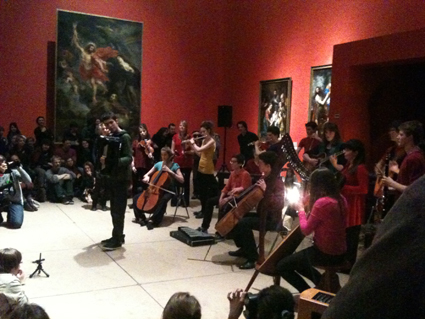
Museum Night Fever, Brussels
photo Sophie Travers
Museum Night Fever, Brussels
The Kaaitheater, Beurschouwburg, Les Brigitinnes and KVS present contemporary theatre, dance and performance, with innovative programming ideas like Kaaitheater’s Burning Ice festival of ecologically themed work or Beurs’ invitation to artists to curate a month long program of visual, screen, lecture and performance works.
Recyclart is a funky underground space that programs workshops and community events and hosts DJs and bands from around the world. Les Ateliers Claus is a subversive institution and L’Ancien Belgique manages to balance big name bands with quirky mini-festivals.
PassaPorta is an extraordinary literary organisation with an annual festival, artists in residence and regular talks from international writers—in all sorts of languages.
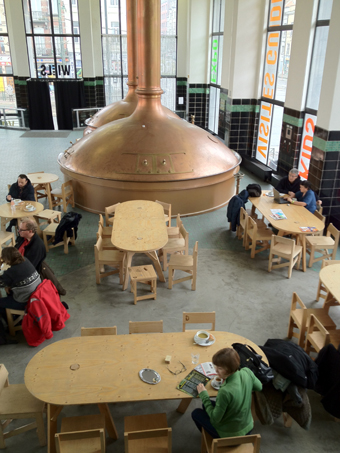
WIELS, Brussels
photo Sophie Travers
WIELS, Brussels
In the visual arts, WIELS is a large three storey space in a former brewery that hosts artists in residence as well as events such as EXISTENZ, a program of live art. Private galleries such as Villa Empain and Maison Particuliere are thrilling discoveries and the Horta Museum is a gem of art nouveau architecture, beautifully preserved. In March, the city runs Museum Night Fever, a long night of events across 23 museums and of course there is the inevitable Nuit Blanche in October when the galleries are open all night.
for refreshment
Brussels has a huge offering of bars and cafes where you can enjoy the hundreds of varieties of Belgian beer. Traditional spots, such as A La Morte Subite remain frozen in time with their tarnished mirrors, cheese-on-stick snacks and mind-boggling lists of gueuzes, lambics, trappists and, my personal favourite, fruit beers.
Modern drinking holes include the deco Belga Café on the Place Flagey in Ixelles. Day or night, this place is always buzzing and brunch on a weekend, after a visit to the produce market on the square, is another personal Brussels highlight.
The plat du jour option offered by most brasseries at lunchtime is a great option for the traveller, enabling you to sample the more upmarket eateries for a fraction of the à la carte cost. A lovely spot in the picturesque Galleries Hubert is L’Ogenblik where the 11 Euro lunch dish is usually a Flemish special such as Chicons Gratins or Stoemp.
A trip to Brussels is not complete without moules and frites and any of the many restaurants around the Place St Catherine offer a steaming pot of mussels. If you are on a budget join those standing at the bar of Noordzee, a fish-shop on the same square, whose white wine, fish soup and crispy croquettes are hugely popular, especially on a warm summer evening. Even more skint? Head to a fritkot, the ubiquitous hot chip stands and join the city-wide debate about which one reigns supreme.
other highlights
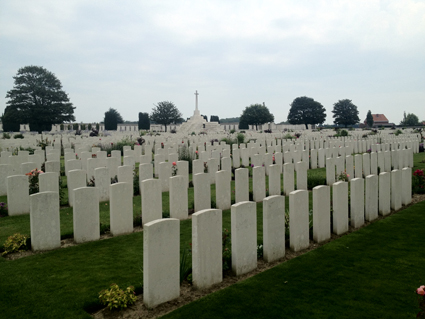
Cemetery in Ypres, Belgium
photo Sophie Travers
Cemetery in Ypres, Belgium
The proximity of Ghent, Bruges and Antwerp make for great day trips, especially as weekend train tickets are half price and no journey is over an hour. Those who enjoy nature can head to the Ardennes for some walking and sea lovers can head north to Oostend where a Marvin Gaye inspired headphone tour illuminates this rather forbidding resort. In Ypres the In Flanders Fields Museum commemorating World War I is shattering; the Herge Museum in Louvain-la-Neuve is fun, and of course, everyone must have their Waterloo.
links
BOZAR www.bozar.be
Kunstenfestivaldesarts www.kfda.be
ArsMusica www.arsmusica.be
Flagey Arts Centre www.flagey.be
Kaaitheater www.kaaitheater.be
Beurschouwburg www.beursschouwburg.be
Les Brigitinnes www.brigittines.be
Recyclart www.recyclart.be
Les Ateliers Claus www.lesateliersclaus.com
L’Ancien Belgique www.abconcerts.be
PassaPorta www.passaporta.be
KVS www.kvs.be
WIELS www.wiels.org
Villa Empain www.villaempain.com
Maison Particuliere www.maisonparticuliere.be
Horta Museum www.hortamuseum.be
Museum Night Fever www.museumnightfever.be
Nuit Blanche www.nuitblanchebrussels.be
A La Morte Subite www.alamortsubite.com
Belga Café www.cafebelga.be
L’Ogenblik www.ogenblik.be
Noordzee www.vishandelnoordzee.be
Marvin Gaye www.marvingaye.be
n Flanders Fields Museum www.inflandersfields.be
Herge Museum www.museeherge.com
Sophie Travers is a Scottish born performing arts producer, based in Brussels till July 2013, at which point she will return to Melbourne where she has been living for over a decade, running gallusarts.com.
arts house season 1, 2014
Arts House is currently calling for expressions of interest to develop or present work as part of their 2014 Season 1 at the North Melbourne Town Hall, Warehouse or the Meat Market. Financial support up to $12,000 (including in-kind venue support) is offered for CultureLAB developments and up to $30,000 (including in-kind venue support) for full presentations. Interested applicants should discuss their project with Arts House staff prior to applying
Applications close May 31 http://www.melbourne.vic.gov.au/ArtsHouse/fundinggrants/Pages/Fundingandgrants.aspx
revelation perth international film festival
The people at Revelation appreciate that for non-residents Perth can seem a long way away and so for the fifth year they are offering travel fellowships that will provide a festival gold pass, access to seminars and workshops, and a $1,000 re-imbursement for travel costs plus more. Applications are invited from “filmmakers, academics, craftspeople or film-lovers” (website).
Deadline 24 May; http://www.revelationfilmfest.org/go/travel/travel-fellowship
exploring modular synthesis workshop & aws, wired lab
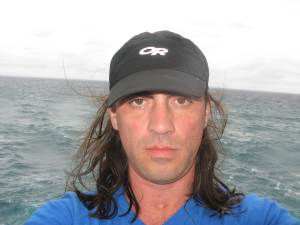
Russell Haswell
courtesy the artist
Russell Haswell
Wired Lab, based in Cootamundra, regional NSW will be host to UK multi-disciplinary artist and “synthesist” Russell Haswell. Together with Wired Lab founder Dave Burraston, they will be running a two-day Modular Synthesis workshop May 18-19. Through its Artist Workshop Scheme, Wired Lab is offering 10-15 emerging or mid-career artists financial assistance to travel and take part in the activities.
Applications for workshop & AWS due May 6: more info http://wiredlab.org
the 2013 hive production fund
The Hive (supported by Adelaide Film Festival Investment Fund, Australia Council for the Arts, ABC Arts and Screen Australia) is currently calling for proposals from artists and filmmakers for the production of documentary, hybrid and drama projects to be premiered at the 2015 Adelaide Film Festival and broadcast on ABC TV. Applications are sought from teams that include an established director or co-director and an experienced film producer. The total funding pool is $800,000 with a feature film funded for up $450,000 and a half-hour documentary/hybrid work up to $150,000.
Applications due May 13; more info http://www.adelaidefilmfestival.org/default.asp?contentID=353
arstpace curatorial fellowship
Aimed at the professional development of an early career visual arts curator, Artspace (with the support of the Australia Council for the Arts) is offering a 12-month curatorial fellowship starting June 2013. As well as fulfilling a role similar to an assistant curator the curatorial fellow will also have the opportunity to develop a key project.
Applications close May 8; http://www.artspace.org.au/content/pdf/Curatorial_Fellow_Description.pdf
channels video art festival
There’s a new kid on the media art biennial block— Channels Video Art Festival. Run by Rachel Feery, Jessie Scott and Eugenia Lim, it will take place in Melbourne Sept 18-21 at ACMI, Screen Space and Speak Easy. The team are already leaking the news of special installations commissioned from Ms&Mr and Benjamin Ducroz. The festival is currently calling for entries of “video art that both knows its past and has a mark to make on the future” (website).
Deadline June 1; more info http://www.channelsfestival.net.au/
proximity festival
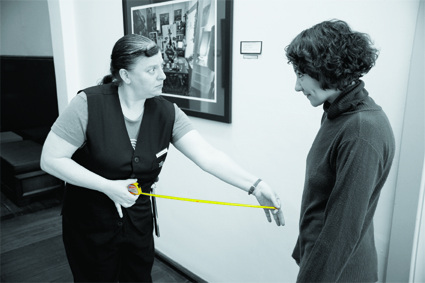
Nikki Jones and audience
member, Ush and Them, Proximity
Micro Festival of One-on-One Art
photo Ashley de Prazer
Nikki Jones and audience
member, Ush and Them, Proximity
Micro Festival of One-on-One Art
Proximity is a Perth-based festival focussing on one-on-one performance and experiences. The first manifestation in 2012 included beard fondling, a game of strip poker, a private hoofer viewing, a three-minute shower and a slow cooked meal (to get the gist see Laetitia Wilson’s review RT108). Festival curators James Berlyn and Sarah Rowbottam are now calling for proposals for the 2013 manifestation.
Deadline May 17; http://proximityfestival.com/
heartlands refugee art prize
Applications are sought from refugees who have arrived in Australia since 1970 for the Heartlands Refugee Art Prize. There is a prize pool of $20,000 ($12,000 going to the overall winner) and the theme for this year’s competition is “I wish to see…” The award is run by Multicultural Arts Victoria in partnership with Parks Victoria, VicHealth and the Victorian Multicultural, and the shortlisted entries will be exhibited in fortyfivedownstairs June 18-29, as part of Refugee Week, with further presentations later in the year.
Applications close May 10; more information http://www.multiculturalarts.com.au/events2013/heartlands.shtml
hidden: rookwood cemetery sculpture walk
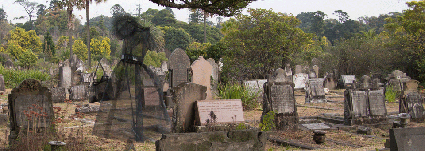
Afterimage, Lyndal Hargrave and Sue Henderson, HIDDEN: Rookwood Cemetery Sculpture Walk
courtesy the artists & HIDDEN
Afterimage, Lyndal Hargrave and Sue Henderson, HIDDEN: Rookwood Cemetery Sculpture Walk
Since 2009 Rookwood, the largest cemetery in Australia, has been host to HIDDEN, a sculpture walk that aims to reposition the site as “a place rich in heritage, history, culture” rather than just for “funerals and memorials” (website). The exhibition takes place September 21-October 31 and the call for entries is now open. There is a non-acquisitive Rookwood Necropolis Sculpture Award valued at $10,000 with range of smaller prizes as well.
Application deadline May 6; more info http://www.hidden.rookwoodcemetery.com.au/
RealTime issue #114 April-May 2013 pg. web
© RealTime ; for permission to reproduce apply to realtime@realtimearts.net
opal vapour, jade dewi tyas tunggal, mobile states
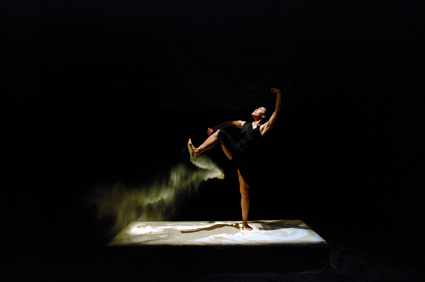
Jade Dewi Tyas Tunggal, Opal Vapour
photo Paula van Beek
Jade Dewi Tyas Tunggal, Opal Vapour
The Mobile States touring alliance continues to join the dots across the country adding new partners every year. First up for 2013, travelling to eight venues—north, south, east and west—is Jade Dewi Tyas Tunggal’s Opal Vapour, a dance and video work made in collaboration with singer/composer Ria Soemardjo and lighting designer Paula van Beek. Opal Vapour has been developed between Australia and Indonesia and explores elements of Javanese Wayang Kulit shadow puppetry and performance rituals.
Mobile States Tour: Vitalstatistix, Adelaide, May 8-12; Perth Institute of Contemporary Arts, May 15-18; Salamanca Arts Centre, Hobart, May 22-25; Centre of Contemporary Arts, Cairns, May 28-29; Mackay Entertainment Centre, May 31-June 1; Visy Theatre, Brisbane Powerhouse, June 5-8; Canberra Street Theatre,?June 14-15; Blacktown Arts Centre,?June 19-22; http://performinglines.org.au/productions/opal-vapour/; http://opalvapour.com.au/
gemeinboeck & saunders, velonaki, ingram, artspace
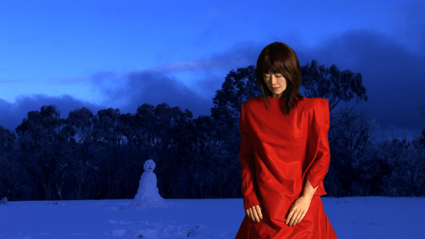
Mari Velonaki, The Woman and the Snowman, 2009-present, production image
courtesy of the artist and Anna Schwartz Gallery
Mari Velonaki, The Woman and the Snowman, 2009-present, production image
As ISEA2013 draws nearer Sydneysiders might find the city increasingly overrun by robots—Artspace’s ISEA-satellite exhibition marks the advent of the invasion. Petra Gemeinboeck and Rob Saunders will literally infest the gallery walls with playfully destructive robots while New Zealand artist Simon Ingram’s robots will engage in repainting it. Mari Velonaki will take a philosophical approach exploring the concept of the ‘uncanny valley,’ [http://en.wikipedia.org/wiki/Uncanny_valley ] pitting one of Professor Hiroshi Ishiguro humanoid robots against a snowman. (See RT111 and RT93.)
ISEA satellite exhibition, Artspace, Sydney, May 2-June 16; http://www.artspace.org.au/gallery_upcoming.php
composition to movement festival, creative practice lab, unsw
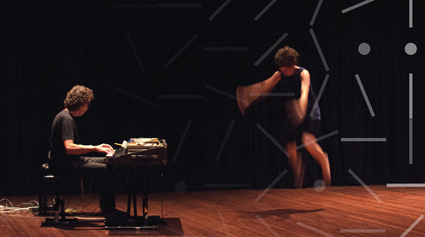
Alister Spence and Nalina Wait, Composition to Movement Festival, Creative Practice Lab, UNSW
photo Paul Matthews
Alister Spence and Nalina Wait, Composition to Movement Festival, Creative Practice Lab, UNSW
As part of Vivid Sydney, the Creative Practice Lab at the University of New South Wales is producing a mini-festival focusing on collaboration, in particular the relationship between dance and music. The three day event includes a key note lecture by Ross Harley (the new Dean of CoFA); a concert by the Australia Ensemble featuring a new collaboration between choreographer Sue Healey and composer John Peterson; a day of workshops in which you can watch the collaborative process in action; and a final presentation of explorations by dancer Nalina Wait with pianist Alister Spence and saxophonist Sandy Evans, and choreographer-dancer Martin del Amo with sound artists Madeleine Flynn and Tim Humphrey.
UNSW: Creative Practice Lab, School of Arts & Media: Composition to Movement Festival, Io Myers Studio, Clancy Auditorium and various UNSW venues, Sydney, May 24-26, part of Vivid Sydney
http://sam.arts.unsw.edu.au/c2m/
eve and eve, rebecca agnew, 24hr art
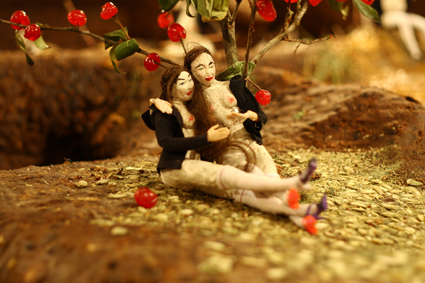
Eve and Eve (video still, 2012) stop-animation
courtesy the artist
Eve and Eve (video still, 2012) stop-animation
In a set constructed from fruitcake and jelly (amongst other things), Rebecca Agnew has created a stop motion animation, Eve and Eve, telling the tale of two women in paradise. There is the inevitable downfall, paradise is lost and somehow a suicide bomber becomes involved. The mysteries of this painstakingly constructed work will be revealed at 24HR Art in an exhibition suite which also includes pieces by Agnieszka Golda & Martin Johnson, Mark Daniel and Gareth Jenkins. Check out Agnew’s website for some captivating images and video clips.
Eve and Eve, Rebecca Agnew, 24HR Art, Darwin, May 3; http://www.24hrart.org.au/
r&j, expressions dance company, national tour
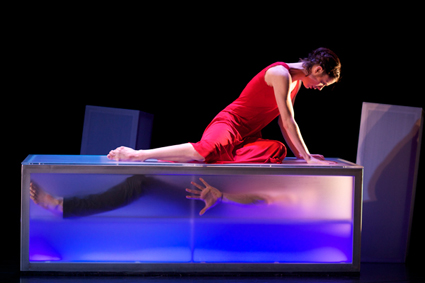
Samantha Mitchell, Jack Ziesing, R&J, Natalie Weir/Expressions Dance Company
photo Fiona Cullen
Samantha Mitchell, Jack Ziesing, R&J, Natalie Weir/Expressions Dance Company
R&J is a re-interpretation of Shakespeare’s famous love story choreographed by Expressions Dance Company director Natalie Weir. After a successful premiere performance in 2011 and a South Australian outing, the show is now in the middle of an 18-venue regional tour of Tasmania, Victoria, New South Wales and Queensland. Weir approaches the tale using three stories set in different eras to convey the universality of the romantic narrative. Music is composed by John Babbage and has been recorded by Topology.
Expressions Dance Company and Queensland Performing Arts Centre: R&J, choreographer Natalie Weir; various venues; April 26-June 8; check website for venue information http://www.expressionsdancecompany.org.au/rj-tour-2013/rj-tour-2013/
living in the ruins of the 21st century, uts gallery
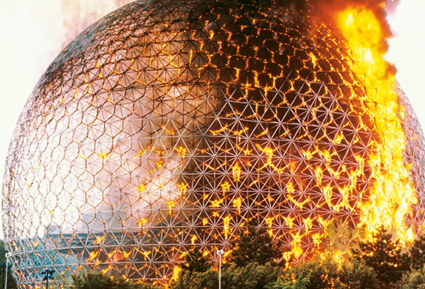
Buckminster Fuller’s Anne’s Taj Mahal on fire, Montreal, 20 May 1976, from Cabinet Issue 32, Fire
Courtesy Cabinet
Buckminster Fuller’s Anne’s Taj Mahal on fire, Montreal, 20 May 1976, from Cabinet Issue 32, Fire
Teaming up with the über cool New York magazine Cabinet, curators Adam Jasper and Holly Williams are presenting a contemporary wunderkammer that draws “together objects from art, science and ethnography in a celebration of the profound and the mundane” (website). The exhibition includes works by over 20 Australian and international artists including Tracey Moffatt, David Haines & Joyce Hinterding, the Institute of Critical Zoologists, Jaki Middleton & David Lawrey and Alex Gawronski as well as objects on loan from The Macleay Museum, MONA and Leipzig’s Stasi Museum. The exhibition will be contextualised by a reading room of Cabinet publications claimed to be the only complete collection in Australia, offering different thematic trajectories through the exhibition.
Living in the ruins of the 21st Century, UTS Gallery, Sydney, until May 17; http://livingintheruins.net; http://www.art.uts.edu.au/gallery/current/current.html
friday nights, metro arts
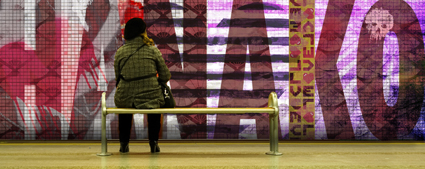
Hanako, Caroline Dunphy, part of Metro Arts May Friday Nights
image SYC Studios
Hanako, Caroline Dunphy, part of Metro Arts May Friday Nights
In Brisbane, Metro Arts’ Friday Night program fully embraces the current cultural focus on audience engagement. Once a month audiences are invited to sample all the creative activities, at various stages of development, inhabiting the building. The May instalment offers a sneak peek of physical performer Caroline Dunphy’s collaboration with Shane Thompson Architects titled Hanako, “a theatrical, cinematic and sensory experience inspired by Hanjo, a modern Noh play written by Yukio Mishima” (press release); Exist’s Cold Metal, inspired by “the theatre of black Metal music” (press release) featuring Stasis Duo and Alrey Batol; and The Psychology Project, by dancer Liesel Zink and psychology researcher Rohan Kapitany (see RT109); Anastasia Booth’s exhibition Crude Tools, Feeble Actions and lots more.
Friday Night: May, Metro Arts, Brisbane, May 3; full program available here; www.metroarts.com.au
hatched & digital now, pica
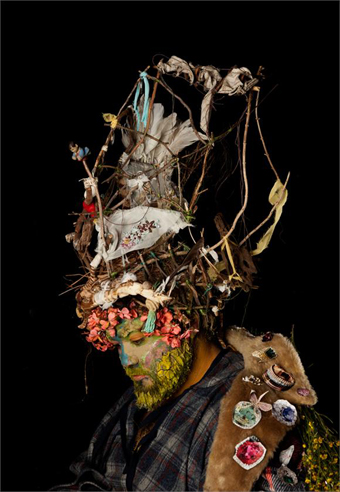
Shan Turner-Carroll, Shan, from the series Primal Crown, 2012, The Doctor Harold Schenberg Art Prize winner, Hatched, PICA
courtesy the artist
Shan Turner-Carroll, Shan, from the series Primal Crown, 2012, The Doctor Harold Schenberg Art Prize winner, Hatched, PICA
Photographer Shan Turner-Carroll has been announced as the winner of The Doctor Harold Schenberg Art Prize, part of PICA’s Hatched: National Graduate Show which features 37 artists from 20 art schools across Australia. As part of the public program Associate Professor Michele Wilson will present Digital Now, an illustrated lecture drawing on her research exploring “engagements with and through technologies and how these influence our understanding of ourselves, our social relations and social practices” (website).
Hatched: National Graduate Show 2013, PICA, Perth, until June 9, digital Now, May 8, http://www.pica.org.au/
natalie abbott, physical fractals, pact
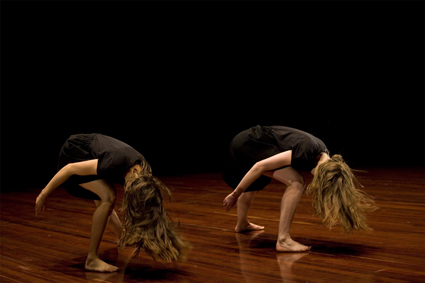
Natalie Abbott, Sarah Aitken, Physical Fractals
photo Ponch Hawkes
Natalie Abbott, Sarah Aitken, Physical Fractals
One of several impressive works by emerging choreographers in Dance Massive 2013 was Natalie Abbott’s Physical Fractals. Varia Karipoff wrote “The performance…messes with our personal sense of gravity and our concept of space” (see DM feature). Physical Fractals is particular interesting for its integration of live sound manipulated by Daniel Arnott. Sydney audiences now get a chance to experience this work at PACT Centre for Emerging Artists. Complimenting the season will be the second installment of PACT’s Saturday Sessions, an informal discussion series about experimental practice, this time focusing on “dance and daily choreographies.”
Natalie Abbott, Physical Fractals, dancers Natalie Abbott, Rebecca Jensen PACT, Erskineville, May 1-10; Saturday Session #2, May 4, 5-6.30pm; http://www.pact.net.au/2013/04/month-of-dance/
no child, nilaja sun, theatre works
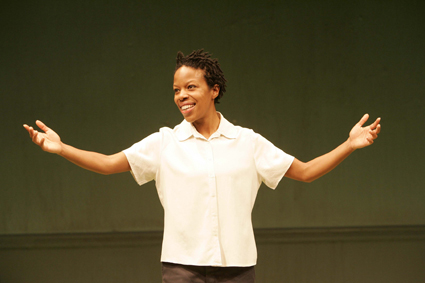
Nilaja Sun, No Child
photo Carol Rosegg
Nilaja Sun, No Child
2012 Melbourne International Art Festival audiences appreciated US writer-performer Nilaja Sun’s No Child so much that she’s decided to do a return season, this time at Theatreworks. No Child draws on Sun’s experiences as a drama teacher in some of New York’s toughest schools, “depict[ing] the battle-ground that US public education has become” (press release). You can see a promo of Sun’s super energetic and entertaining performance here.
No Child, Nilaja Sun, Theatreworks, Melbourne, May 7-26,
http://www.theatreworks.org.au/whatson/event/?id=136
shadowlife, bendigo art gallery
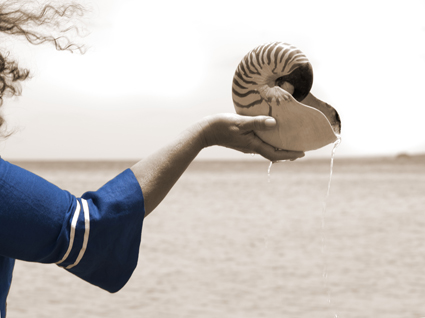
Fiona Foley, The Oyster Fisherman I, 2011, digital print on paper
courtesy of the artist, Andrew Baker Art Dealer, Brisbane, and Niagara Galleries, Melbourne
Fiona Foley, The Oyster Fisherman I, 2011, digital print on paper
Curated by Natalie King and Djon Mundine, Shadowlife explores the “spirit” of photography as implied by the Arnhem Land Djambarrpuyngu word “Wungguli.” It features provocative work by nine leading Australian Aboriginal artists (and one non-indigenous collaborator)—Vernon Ah Kee, Bindi Cole, Brenda L Croft, Destiny Deacon & Virginia Fraser, Fiona Foley, Gary Lee, Michael Riley, Ivan Sen and Christian Thompson. Shadowlife aims to “embrace moving image and photography with all its directness, theatricality and immediacy by confronting stereotypes and acting out scenarios” (press release). Co-presented by Asialink the exhibition will also tour internationally.
Shadowlife, Bendigo Art Gallery, Bendigo, until July 28; http://www.bendigoartgallery.com.au/Exhibitions/Current_Exhibitions/Shadowlife
uta uber kool ja, army of love, judith wright centre
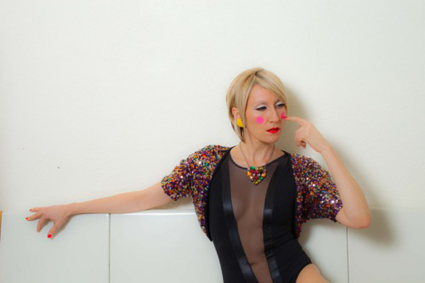
Uta Uber Kool Ja
photo Jeremy Drape
Uta Uber Kool Ja
Experiencing the decadent pleasures of Uta and George as part of Fringe World, Astrid Francis wrote: “With dress-ups, dancing, party games and more spandex than this side of 1985 has seen, Uta celebrates the launch of her remixed single. The guests revel in the sheer hedonism that is Uta—a blend of Eddie and Pats with a touch of Marianne Faithfull” (RT114). Now Brisbane audiences are invited to the exclusive party taking place in the Judith Wright Centre’s studio apartments!
Uta Uber Kool Ja, Army of Love, Judith Wright Centre, Brisbane, May 8-18; http://judithwrightcentre.com/event/uta_uber_kool_ja
RealTime issue #114 April-May 2013 pg. web
© RealTime ; for permission to reproduce apply to realtime@realtimearts.net
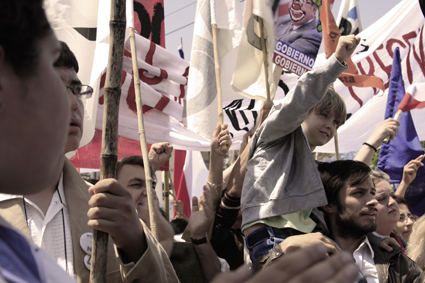
No
courtesy Rialto Distribution
No
Can TV advertising be a force for positive change? The question is seemingly answered in the affirmative in Pablo Larrain’s No.
No is a docudrama set in 1988, when the Chilean people were invited to choose whether free elections would be held or whether the Pinochet dictatorship would stay in power for eight more years (the No of the title indicating a no vote to more Pinochet). As Larrain indicates, the vote was initially seen as a charade, but the authorities soon found themselves with a real fight on their hands.
Like many comparable Australian productions—from Newsfront (1978) to Balibo (2009)—No interweaves archival footage with supposed glimpses “behind the scenes.” Gael Garcia Bernal plays the youthful, skateboard-riding advertising hotshot René Saavedra, who reluctantly agrees to join the “No” campaign, a coalition of progressive groups permitted to broadcast for 15 minutes each day.
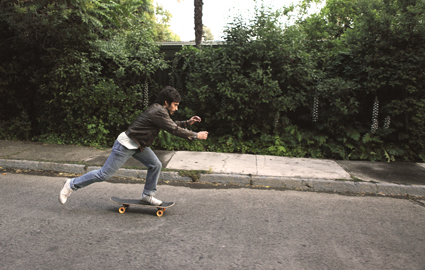
Gael Garcia Bernal, No
courtesy Rialto Distribution
Gael Garcia Bernal, No
Though barely political, René is a man in tune with the times: in the opening sequence we see him proudly unveiling his latest American-style soft drink commercial, where close-ups of the product alternate with images of a clean-cut pop singer performing to an ecstatic crowd. His “No” campaign relies on the same aesthetic, favouring abstract euphoria—street parties, picnicking families, inexplicable mimes—rather than depressing torture statistics or statements from relatives of the disappeared. René’s activist wife (Antonia Zegers) is baffled by the approach. “Who are all these people laughing, celebrating, singing?” she wonders. “What country are you dreaming of?”
Essentially a satirist, Larrain shares some of this scepticism toward pop culture. The fundamentals of advertising may not have changed a quarter-century on, but even the most naïve viewer is liable to regard the clips from the “No” campaign—genuine period pieces, fictionally attributed to René—as dated and naff.
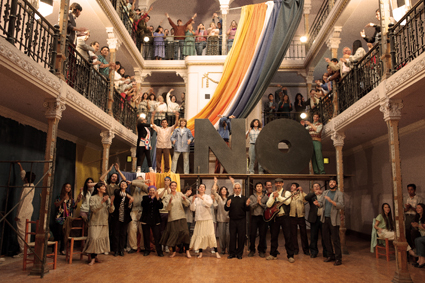
No
courtesy Rialto Distribution
No
The “Yes” advertisements of the government depend on a more traditional, monumental species of kitsch, appealing to national pride with heroic shots of container ships and the beaming general himself. Advertising, it seems, is a language capable of banalising any message: the fact that this language was pioneered by radical filmmakers—from Eisenstein to Bruce Conner—may be part of Larrain’s ironic point.
Further paradoxes arise from Larrain’s decision to shoot on 1980s U-Matic video, with all its technical limitations: murky colour, blown-out backgrounds, minimal depth of field. Though his pseudo-documentary technique contrasts with the rapid-fire editing of the “No” spots, his aim is to create a seamless transition between the two, placing fake reality on the same level as authentic propaganda.
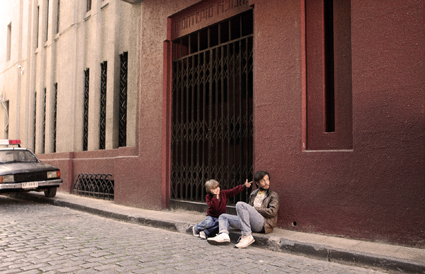
No
courtesy Rialto Distribution
No
Indeed, René is such an elusive, depthless figure he could himself be a character from an ad. In many ways he resembles the CIA agent played by Ben Affleck in Argo (2012): both are technically-minded tricksters, boyish yet reserved, skulking behind their respective beards. Both reveal their humanity chiefly through their love for their young sons, a form of scriptwriting shorthand that smacks of commercial formula: shove a kid in there, and the viewer will have something to really care about.
But though Larrain is not above manipulating his audience, his depiction of admen as heroes still carries an ambiguous subtext. Some kind of tipping point is reached when the “Yes” campaign resorts to parodying its opposition—so that joyous dancers, for example, turn out to be Marxist terrorists in disguise. At this stage, politics appears to have evaporated; what remains is simply a battle between two sets of images, waged in a void.
Much as Argo both celebrates and mocks the American wishful thinking represented by Hollywood, No’s conception of advertising-as-dream is open to varying readings. Chilean audiences might understand the film as a nostalgic evocation of a moment when anything seemed possible; more cynically, the emphasis on marketing as a means of swaying popular opinion might be taken to imply that the hope of democracy in Chile was unreal from the outset.
At home, the film has been criticised for its failure to credit the role played by grassroots activism in drumming up support for the “No” vote. Also skated over is the fact—confirmed in recently declassified documents—that the US government had by this time reversed its earlier positive stance on Pinochet, fearing that resentment of his regime would catalyse the radical left. Not only was financial aid provided for the “No” campaign, but media consultants were dispatched from Washington to assist. Had Larrain chosen to dramatise this scenario, No would be a whole other movie—though it would likely have ended in the same ambivalent way.
No, director Pablo Larrain, Rialto Distribution, in limited national release from April 18; http://au.rialtodistribution.com/no.html
This article originally appeared as part of RT’s Online e-dition May 1, 2013
RealTime issue #115 June-July 2013 pg. 28
© Jake Wilson; for permission to reproduce apply to realtime@realtimearts.net





 Australian ex-patriot Mackenzie Wark contributed many provocative articles to RealTime in the 1990s on media art and culture (all of which will soon be available as part our Media Art Archive, launching during ISEA). His latest book, The Spectacle of Disintegration is part two of his research into the Situationists. Here he follows the movement after the 1968 riots, including an in depth look at the film work and early game theories of Guy Debord. According to the press release “Wark builds on their work to map the historical stages of the society of the spectacle, from the diffuse to the integrated to what he calls the disintegrating spectacle” (Verso website). Furtherfield Gallery London will be hosting an afternoon discussion with Wark, introduced by writer/academic Dr Richard Barbrook (Imaginary Futures: From Thinking Machines to the Global Village. (Pluto Press, 2007).
Australian ex-patriot Mackenzie Wark contributed many provocative articles to RealTime in the 1990s on media art and culture (all of which will soon be available as part our Media Art Archive, launching during ISEA). His latest book, The Spectacle of Disintegration is part two of his research into the Situationists. Here he follows the movement after the 1968 riots, including an in depth look at the film work and early game theories of Guy Debord. According to the press release “Wark builds on their work to map the historical stages of the society of the spectacle, from the diffuse to the integrated to what he calls the disintegrating spectacle” (Verso website). Furtherfield Gallery London will be hosting an afternoon discussion with Wark, introduced by writer/academic Dr Richard Barbrook (Imaginary Futures: From Thinking Machines to the Global Village. (Pluto Press, 2007).







 While still small in number, the books about Australian experimental music and sound are beginning to claim some space on library shelves. The latest addition is by academic Linda Kouvaras, the result of an ARC Research grant. It investigates “experimentalism from its inception in the early twentieth century…[and] how sound is embedded within local, national, gendered and historical environments” with a particular focus on Australian practice (press release). The book will be launched by Warren Burt, June 5, at the Grainger Museum, The University of Melbourne.
While still small in number, the books about Australian experimental music and sound are beginning to claim some space on library shelves. The latest addition is by academic Linda Kouvaras, the result of an ARC Research grant. It investigates “experimentalism from its inception in the early twentieth century…[and] how sound is embedded within local, national, gendered and historical environments” with a particular focus on Australian practice (press release). The book will be launched by Warren Burt, June 5, at the Grainger Museum, The University of Melbourne.




























































 CD review
CD review

























